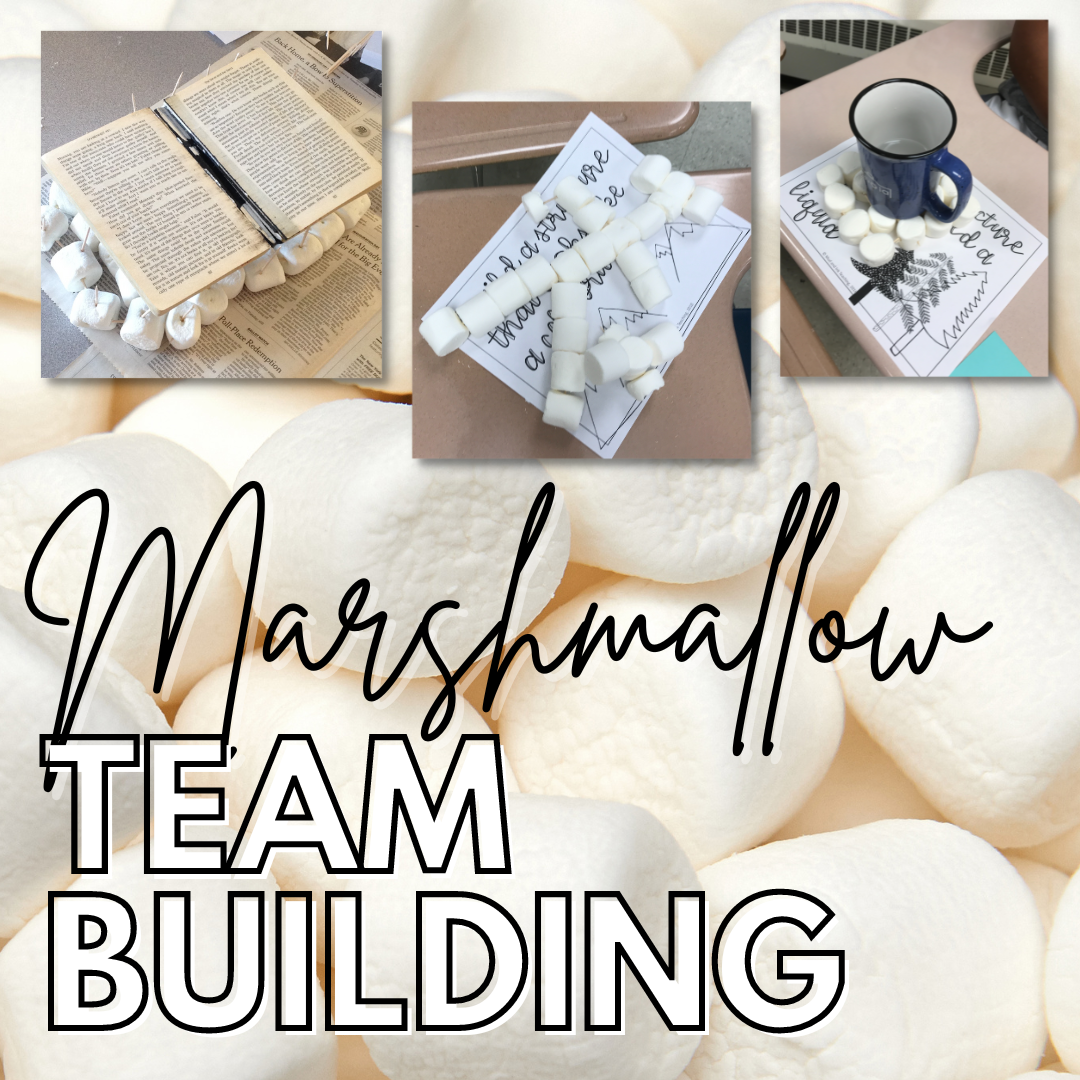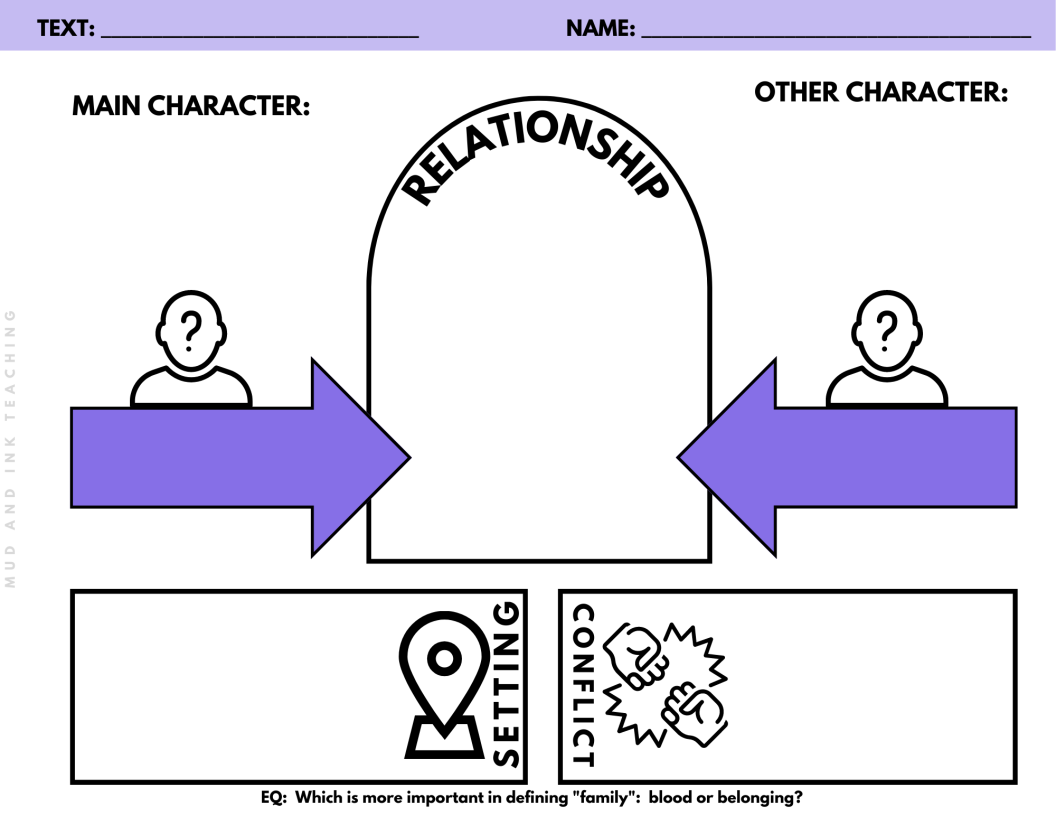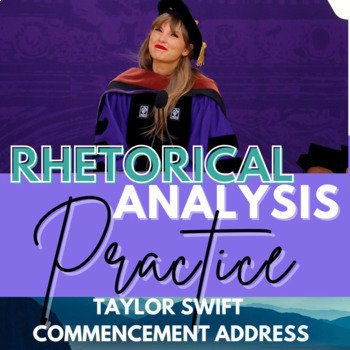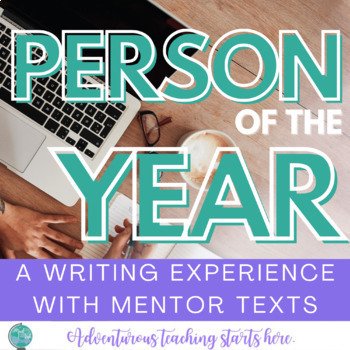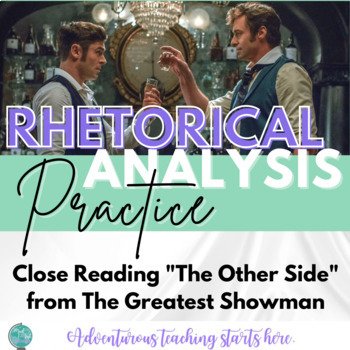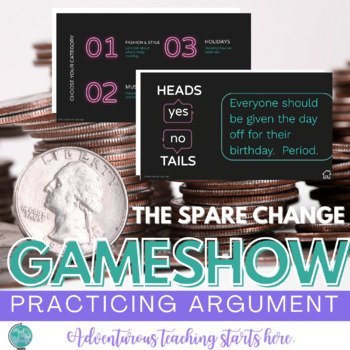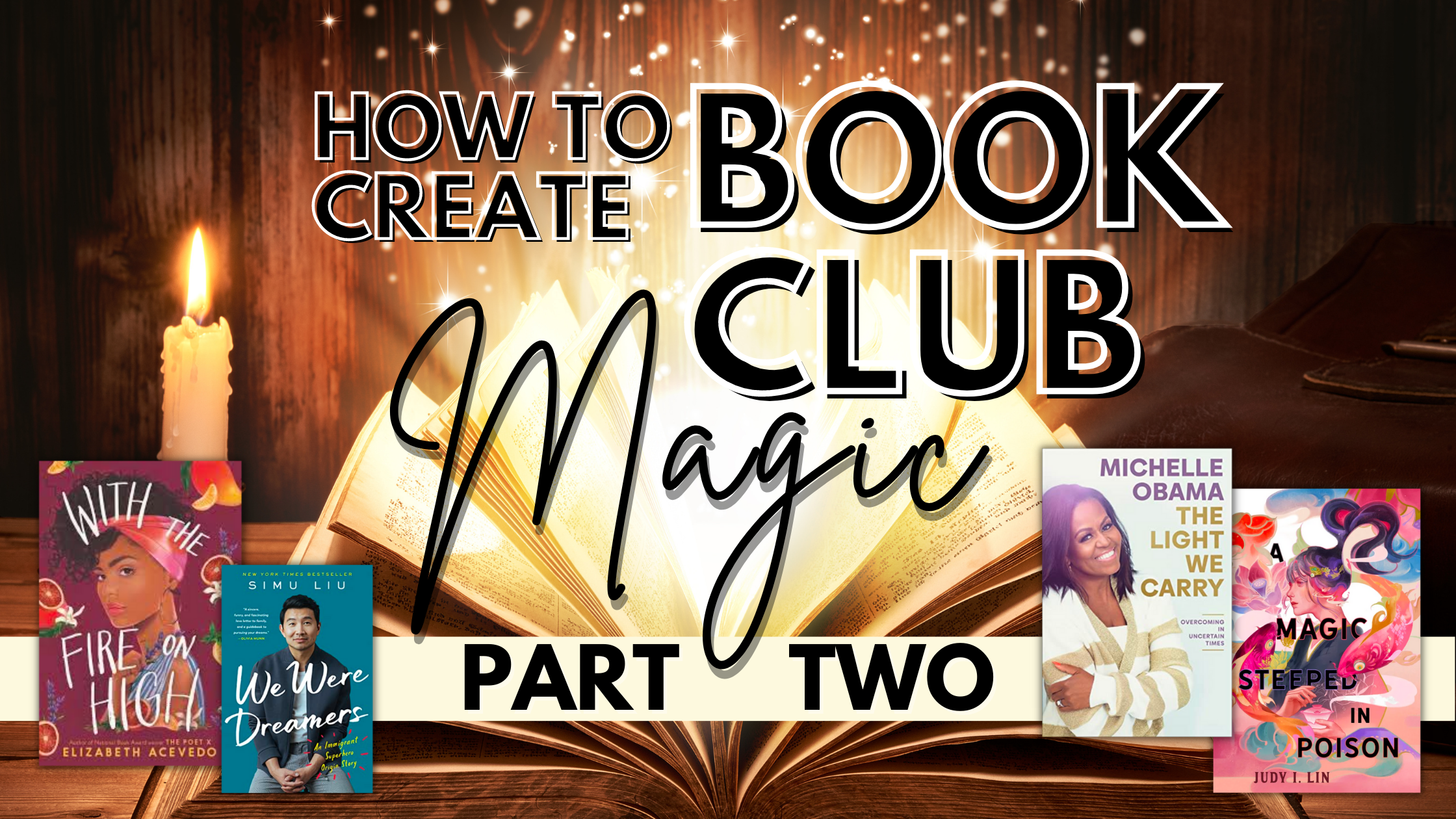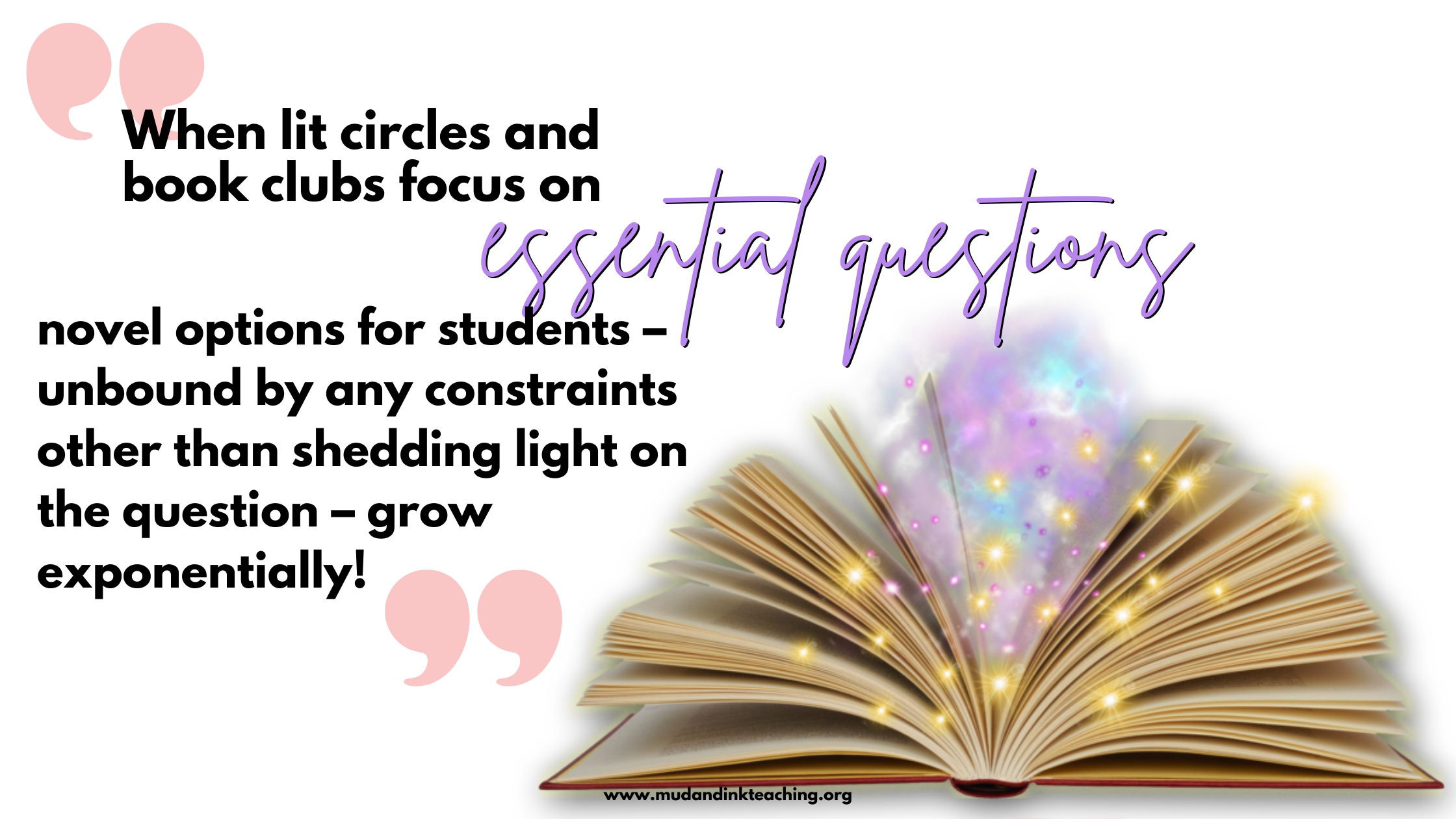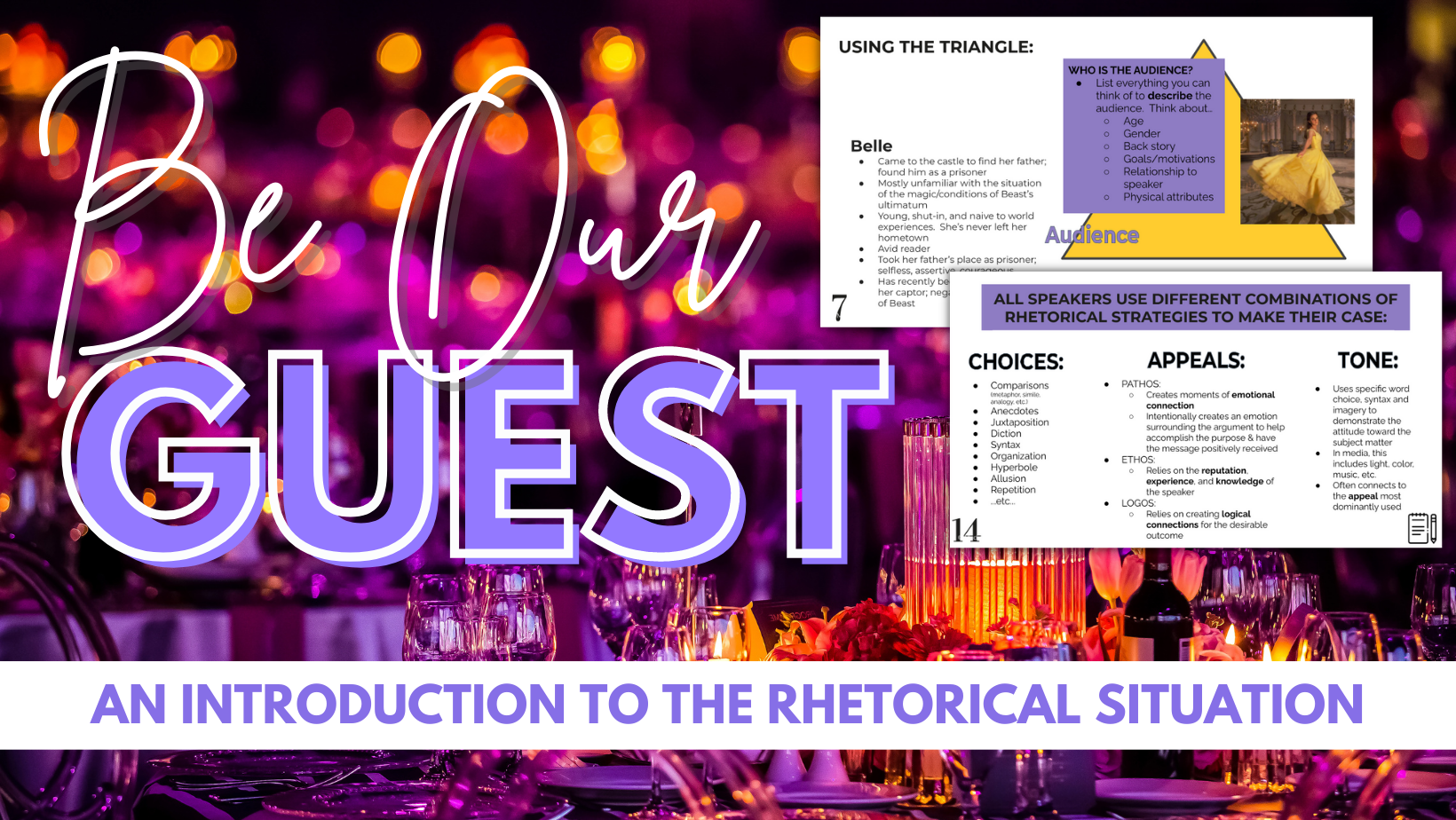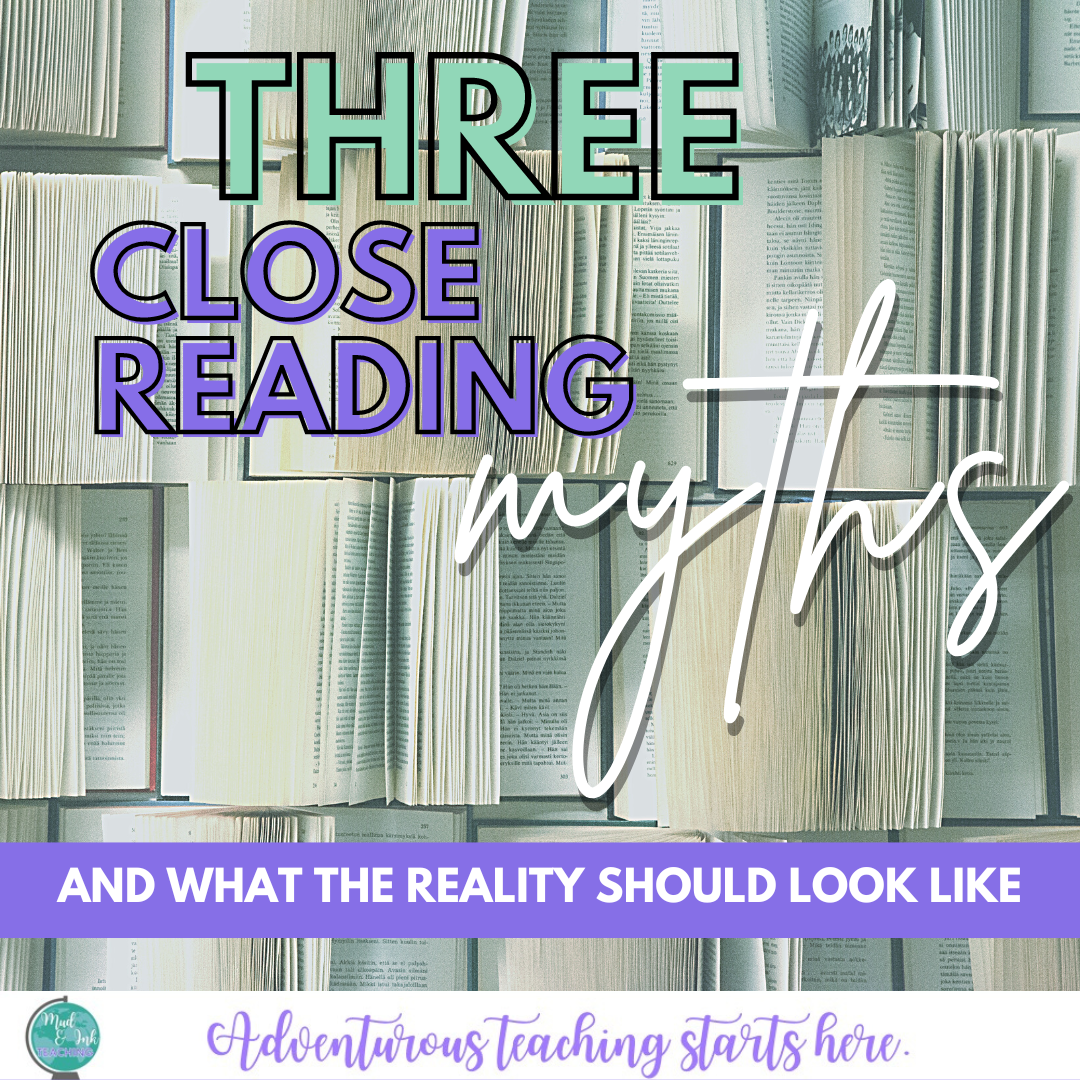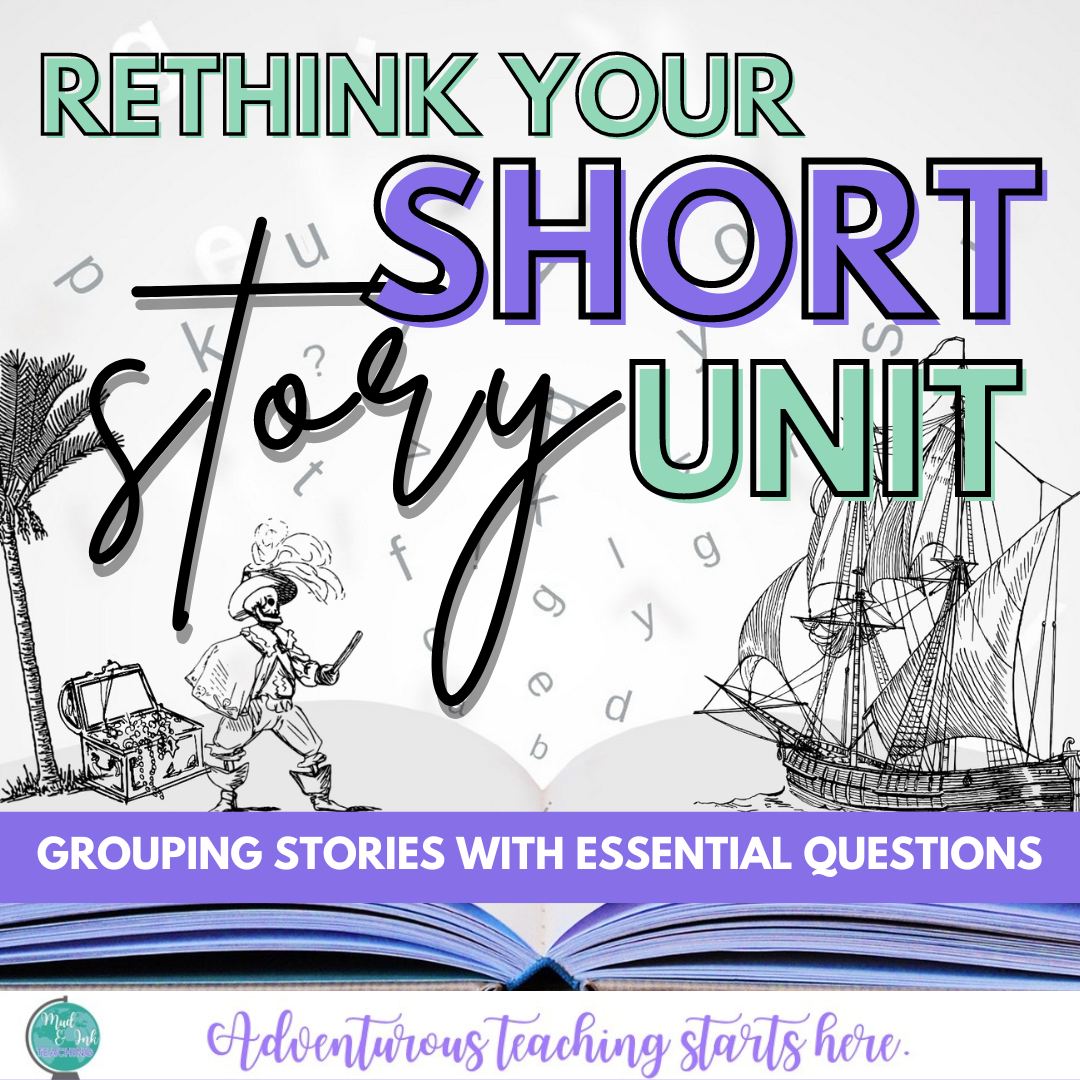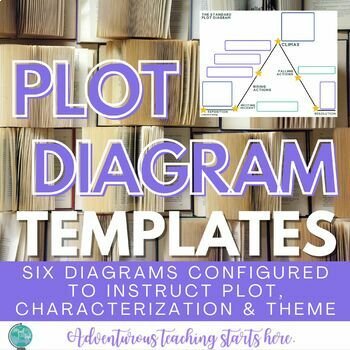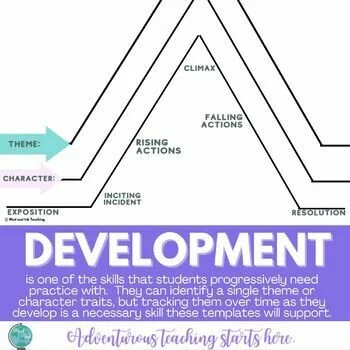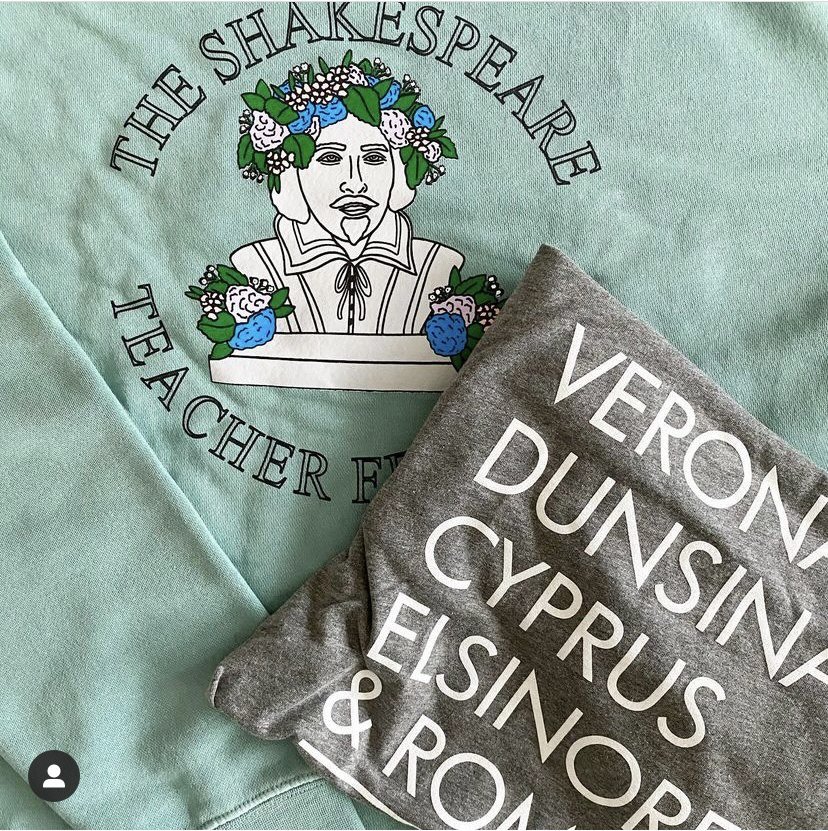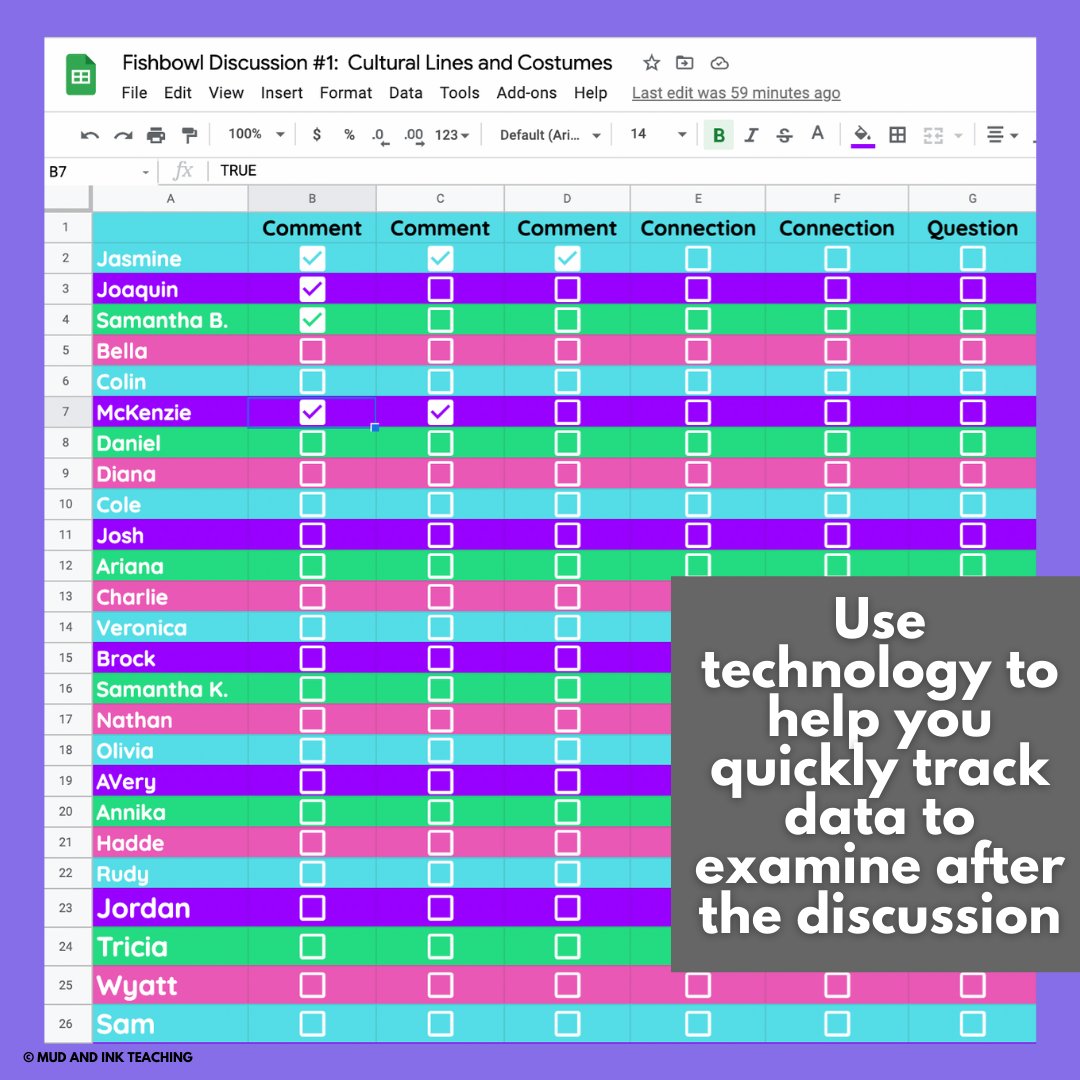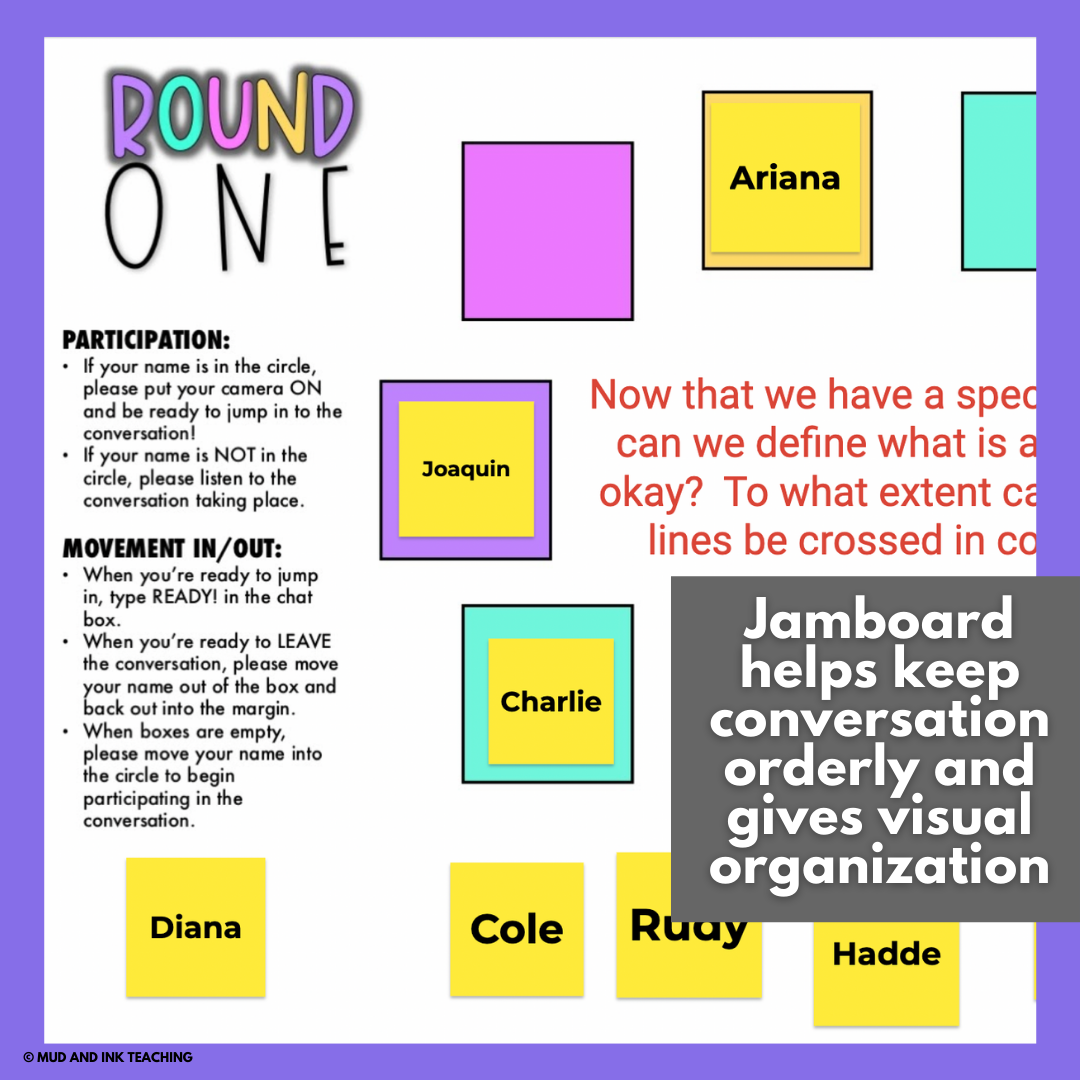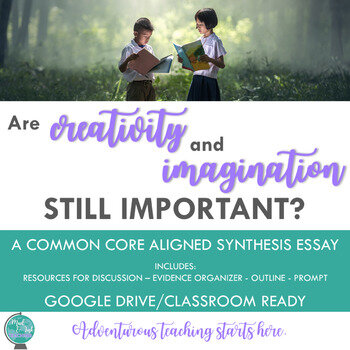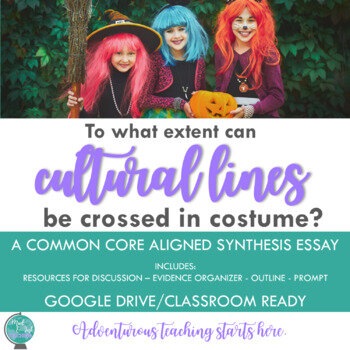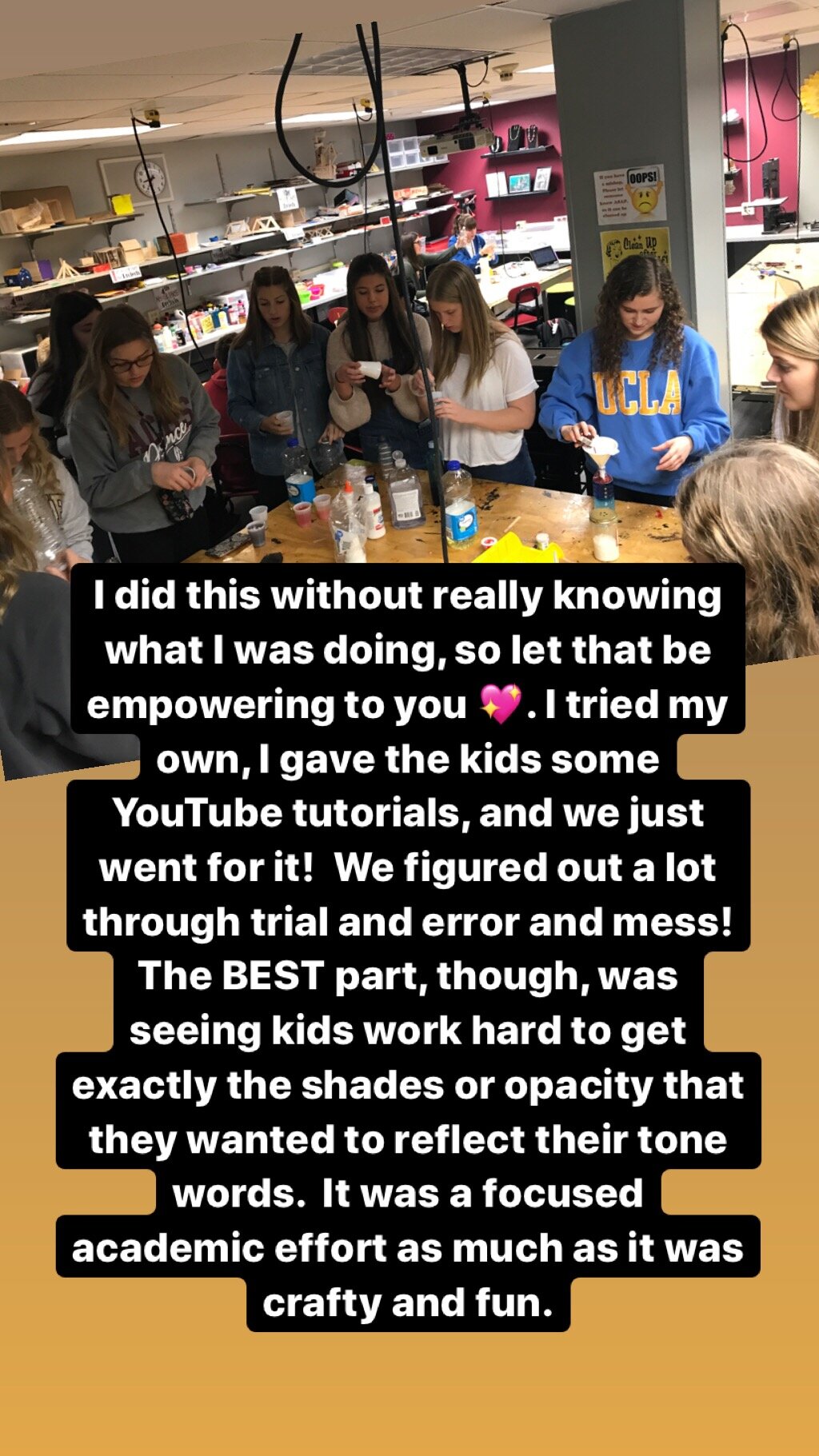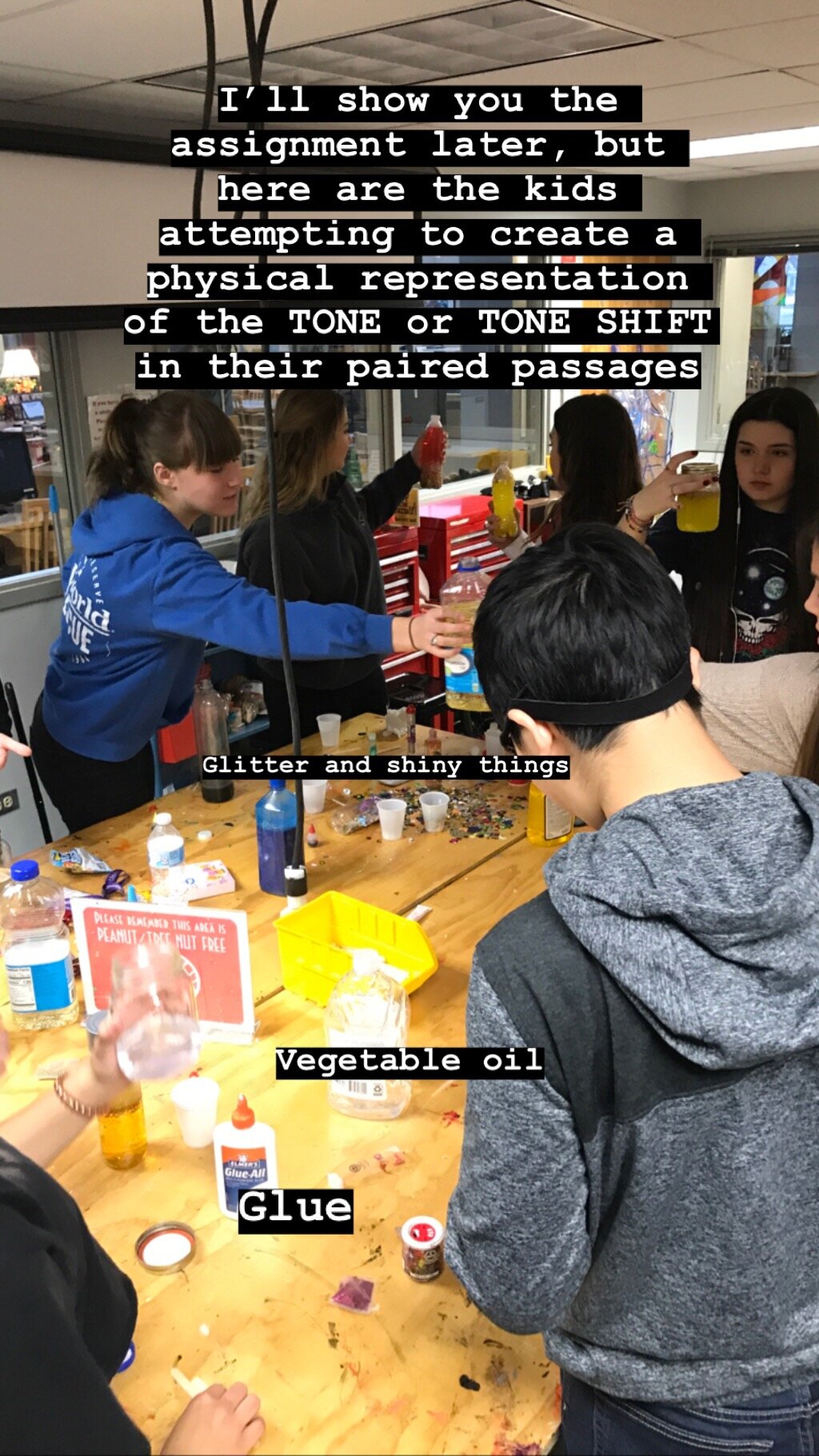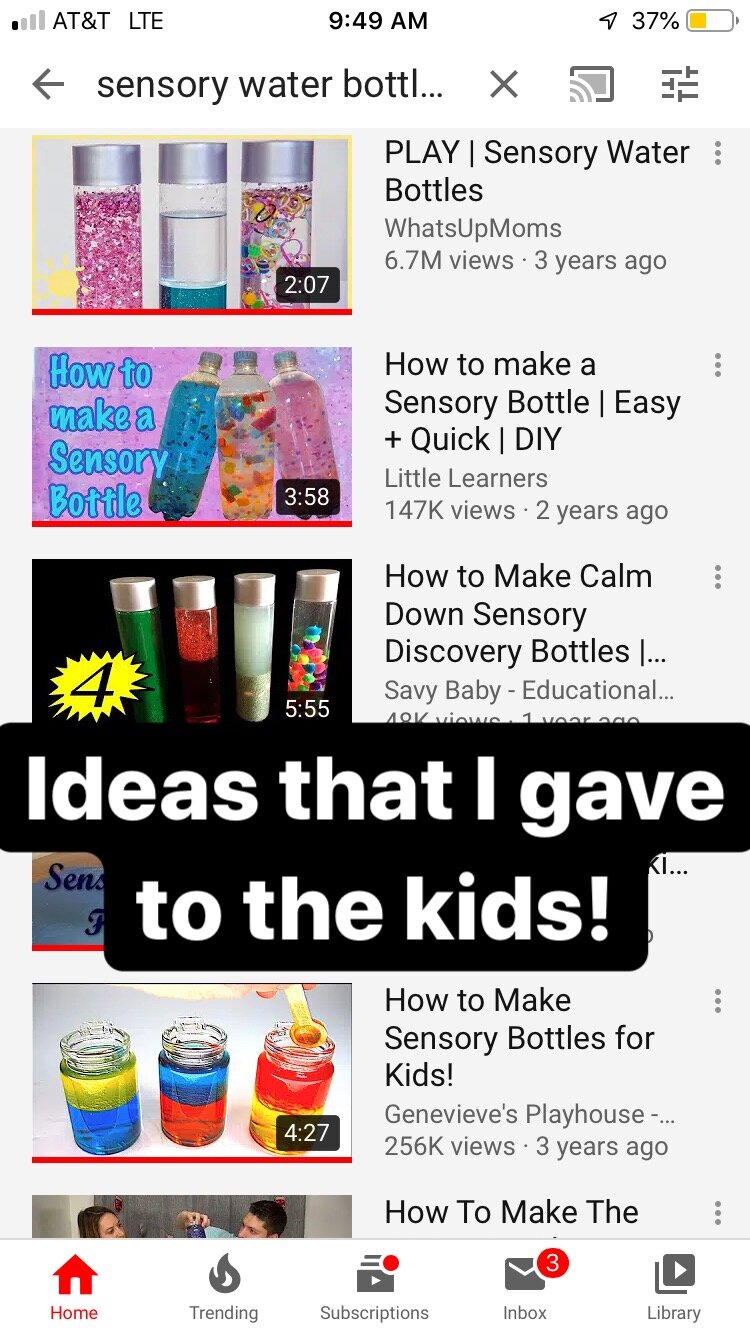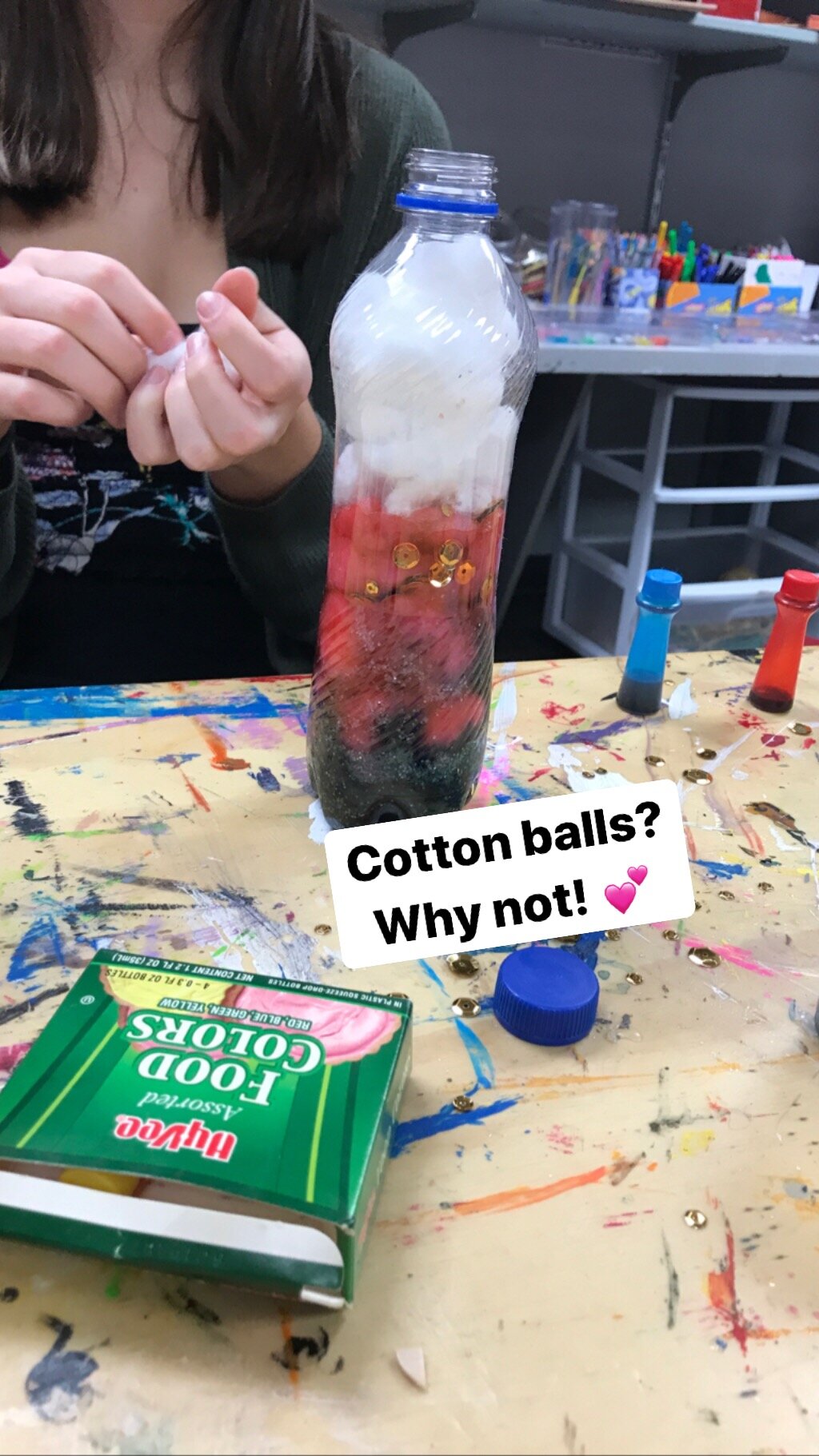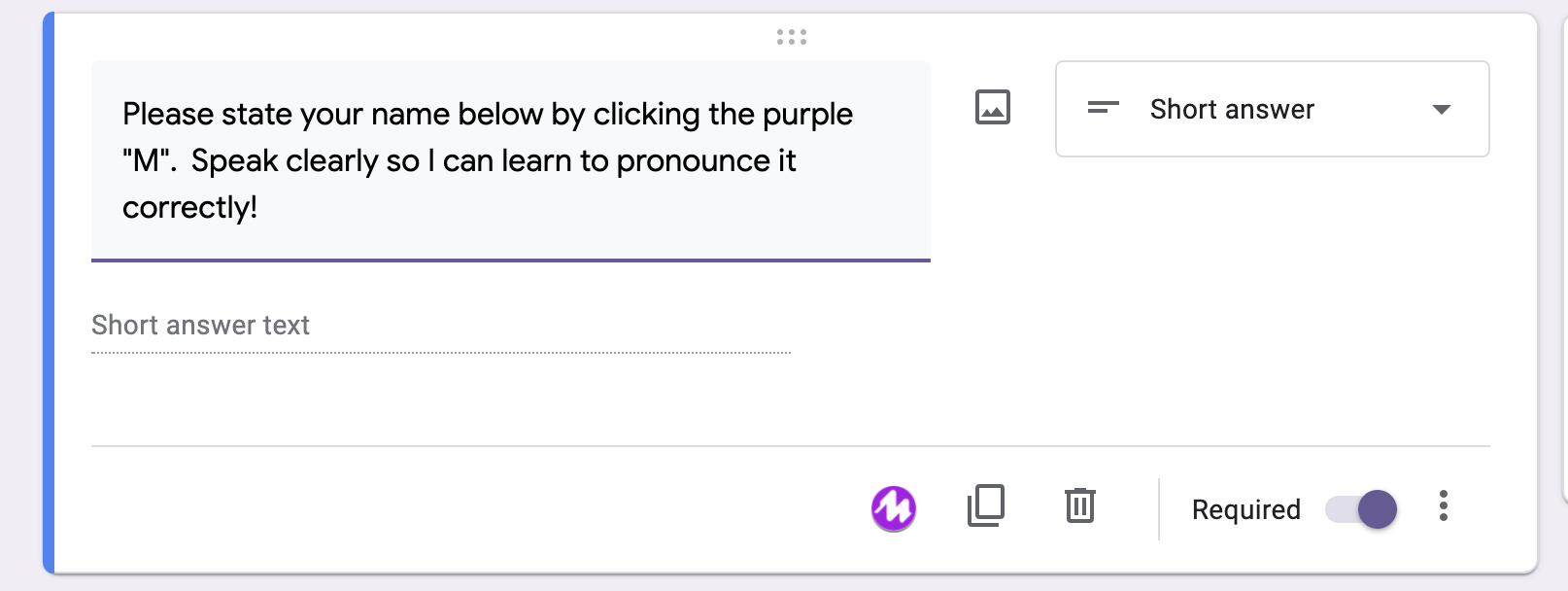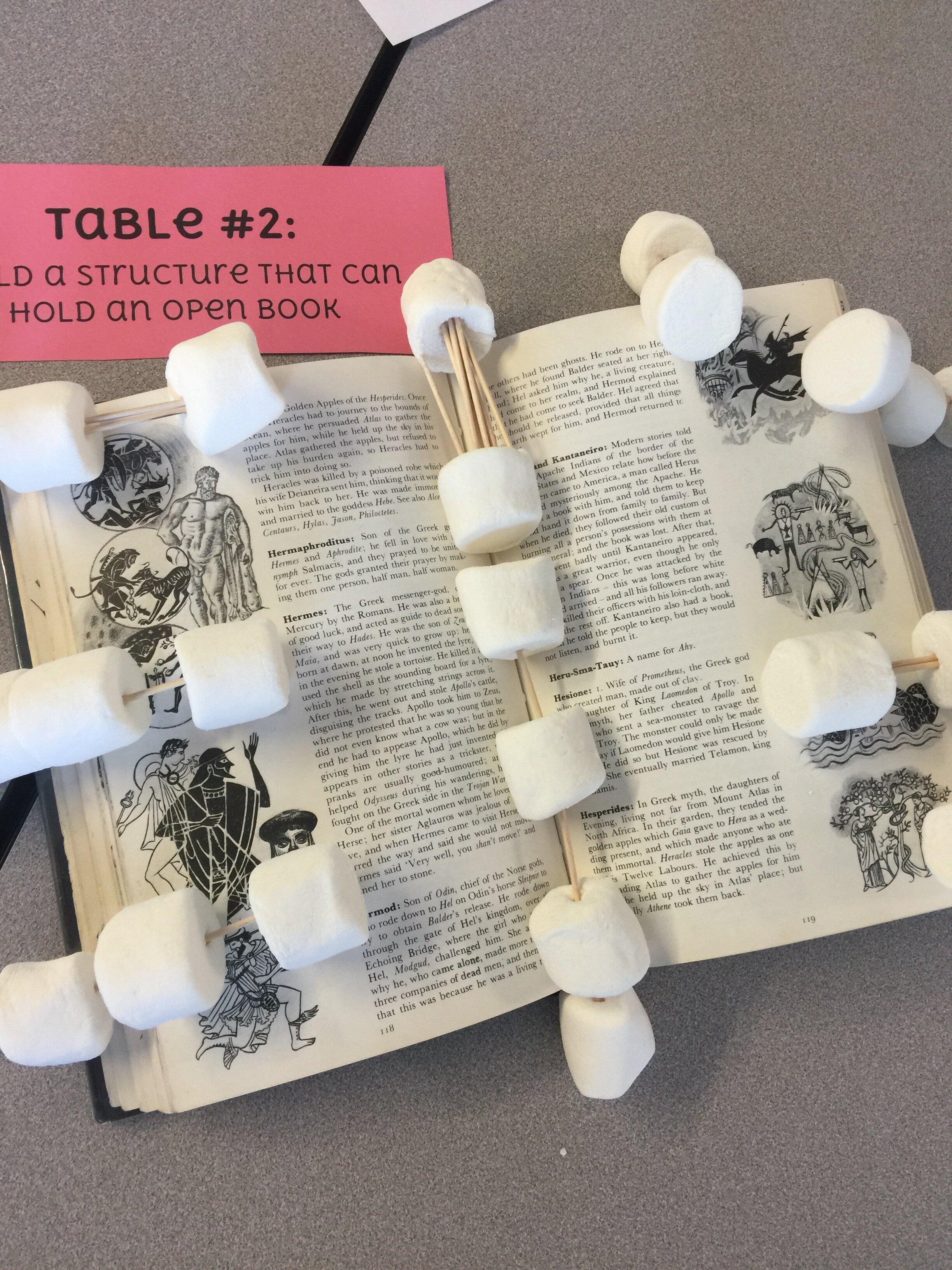
ADVENTUROUS TEACHING STARTS HERE.
Cultivating Critical Thinkers: My Approach to Teaching Literature
As an educator, I've always been passionate about instilling critical thinking skills in my students. It's a topic that I recently had the opportunity to reflect on during a professional development session, and I want to share with you the insights and strategies that I believe are essential for deep engagement in the classroom.
Cultivating Critical Thinkers: My Approach to Teaching Literature
As an educator, I've always been passionate about instilling critical thinking skills in my students. It's a topic that I recently had the opportunity to reflect on during a professional development session, and I want to share with you the insights and strategies that I believe are essential for deep engagement in the classroom.
Challenging the Status Quo
During a recent PD session, I found myself in a bit of a controversial spot. I questioned a fellow teacher's approach to curriculum, which led to a broader discussion about our roles as educators. It's crucial for us to think like our students and to prioritize deep critical thinking over simply entertaining them. We need to focus on developing skills that lead to deeper critical thinking and provide opportunities for students to engage authentically with the material.
Teaching Literature Beyond Comprehension
When it comes to teaching literature, my approach might be a little unconventional. I steer clear of recall-based or plot-based activities. Instead, I encourage students to seek out summaries on their own and focus on the bigger issues at hand. It's about letting go of the minor details and teaching students to read for big picture connections. Comprehension is important, but it shouldn't be the primary focus. We should be guiding our students to think critically about broader themes and societal issues.
The Power of Close Reading
Close reading is a significant part of my teaching strategy. It's not about getting through an entire novel; it's about diving deep into passages and analyzing them. This mirrors adult book club discussions where despite different levels of recall, everyone can contribute meaningfully to the conversation. Close reading fosters a collective understanding of the text and teaches students valuable rhetorical and literary analysis skills.
Pairing Texts and Media for Enhanced Engagement
I'm a big advocate for pairing contrasting texts and media to stimulate critical thinking. For instance, combining literature with podcasts or other media that address relevant societal issues can create a dynamic learning environment. This approach encourages students to engage critically with the material and see the connections between the text and the world around them.
Visuals and Hands-On Activities
Incorporating visuals and hands-on activities is another way to enhance metaphorical thinking and create moments for critical thinking in the classroom. These methods help students to visualize and interact with the concepts in a tangible way, further deepening their understanding and engagement.
Conclusion: Prioritizing Deep Engagement
My approach to teaching literature and critical thinking is all about prioritizing deep engagement, critical analysis, and real-world connections. It's about cultivating students' ability to think critically about the world around them. As educators, we have the power to shape how our students perceive and interact with the world, and it's our responsibility to equip them with the skills they need to navigate it thoughtfully and analytically.
In the end, the goal is not just to teach literature but to foster a generation of thinkers who can analyze, question, and contribute to society in meaningful ways.
READY TO TRY TEACHING EQ DRIVEN UNITS?
LET’S GO SHOPPING
Planning a Novel Unit Reading Calendar
The art of pacing out the reading during a novel unit can be tricky, so we’re going to take some time today to talk through the process. Whether you’re teaching a classic or a contemporary YA title, there are special considerations to be made for the design of your calendar and how we backwards plan for ELA. Let’s jump in!
Planning a Novel Unit Reading Calendar
The art of pacing out the reading during a novel unit can be tricky, so we’re going to take some time today to talk through the process. Whether you’re teaching a classic or a contemporary YA title, there are special considerations to be made for the design of your calendar and how we backwards plan for ELA. Let’s jump in!
For a while now, I've had the pleasure of guiding countless teachers through the intricacies of curriculum design and instructional coaching. In one of our most recent videos, I delved into a topic that's crucial for any literature teacher: creating an effective reading calendar. Today, I want to share with you the insights and strategies I discussed for building a reading calendar specifically tailored to the novel Fahrenheit 451. You can skim through this post to see the gist and then watch the full video when you’re ready!
Understanding Your Timeframe
The first step in crafting a reading calendar is to get a clear picture of the real time you have available for the unit. It's not just about the number of days on the calendar; it's about the actual class time you can dedicate to reading, discussions, and assessments. This understanding is foundational because it shapes how you'll pace the novel and plan your activities.
Setting Clear Assessment Goals
Before you dive into the reading schedule, it's essential to set your assessment goals. What do you want your students to achieve by the end of the unit? How will you measure their understanding and engagement with the text? These goals will guide you in structuring your calendar and ensuring that each activity aligns with your objectives.
Structuring for Engagement and Ownership
A well-structured reading calendar does more than just outline what to read and when; it fosters student ownership and engagement with the text. I advocate for backward planning, which means starting with your end goals and working backward to determine the steps needed to get there. This approach ensures that every part of your calendar is purposeful and directed towards your learning outcomes.
Decentering the Text for Broader Discussions
In our discussion, I emphasized the importance of decentering the text to allow for broader analysis and discussions. This means assigning larger chunks of reading at a time and not getting bogged down by focusing solely on the text itself, and instead, focusing on the essential question. By doing so, you create space for students to connect the novel to larger themes and ideas, which enriches their learning experience.
A Week in the Life of a Reading Calendar
PIN ME!
Let me give you a glimpse into how I structure a reading calendar. Mondays are for assigning reading, which sets the tone for the week. Tuesdays are reserved for small group activities, which encourage collaboration and deeper understanding. Wednesdays and Thursdays are perfect for close reading exercises, allowing students to dive into the text's nuances. This structure balances guidance with autonomy, giving students the framework they need while empowering them to take charge of their reading.
Flexibility and Adaptation
One of the most important lessons I've learned is the value of flexibility. Every classroom is different, and what works for one may not work for another. It's okay to adjust the reading schedule based on your school's timetable and to be open to rearranging assessment, small group, and close reading days as needed.
Final Thoughts
Creating a reading calendar for Fahrenheit 451 or any novel is a balancing act between structure and flexibility. It requires an understanding of your timeframe, clear assessment goals, and a willingness to adapt to your students' needs. I encourage you to use the template I've provided as a starting point and to check the description box for additional resources.
I wish you all the best in planning your reading calendar. Happy teaching!
LET’S GO SHOPPING
Does Taylor Swift have a place in the ELA Classroom?
And here's the thing: if your students are talking about Taylor, then so should you. This is an open door into engagement and skill building that is not to be missed. Here are three ways to pull the power of Taylor into your classroom and spike engagement among your students…
Well, let's get this out in the open: I'm NOT a Swiftie. I hope we can still be friends, but Tay Tay doesn't have a hold on me in pure Swiftie fashion. To be clear, I'm also not a hater. I'd call myself “Taylor-Neutral”.
Whether you are a die-hard fan or completely out of the scope of Swiftie life, it's impossible to ignore the continually rising wave of her cultural power. Named 2023's Person of the Year by TIME Magazine, Taylor has more than earned her spot in a national conversation – and I bet you she's part of many conversations in your classroom.
And here's the thing: if your students are talking about Taylor, then so should you. This is an open door into engagement and skill building that is not to be missed.
In some ELA teacher circles, I see a hesitation to bring the world of pop culture into our sacred space of literature and critical thinking, but here’s the thing: pop culture and trending icons of the moment are vital tools in getting our students to cross that bridge from their worlds into the deep thought and skill practice that we want so much for them. It may be Taylor today, but keep your eye on other trends that can work in a similar fashion: to create a connection and start a deeper conversation.
Here are three ways to pull the power of Taylor into your classroom and spike engagement among your students:
I already LOVED teaching my annual Person of the Year assignment, but holy smokes, this year will lead to some exciting debate. Did Beyonce get the honor a few years ago? Nope. Did Taylor? She sure did. Last year's award went to the President of Ukraine as a war raged on, and this year's award goes to Taylor…as the world continues to fall apart.
The conversations and writing possibilities around this assignment are endless, but perhaps the most interesting conversation I've ever had with students was determining the criterion for “Person of the Year”. How can a pop icon win it one year, but political leaders earn it in another? What should be considered when choosing the “Person of the Year”?
Taylor Swift's commencement address at New York University has been a favorite of teachers for a long time. This assignment is a highly engaging way to get students to practice their rhetorical analysis skills and break down Swift's approach in sending off a class of graduating students. It’s inspirational for our high school students to envision this stage of their lives - whether or not students are college-bound. The speech is about moving into adulthood and holding firm to one’s identity - a message that will resonate with all students.
This lesson is wonderful to do as an introduction to rhetorical analysis (although it is a bit longer than I’d like — I suggest cutting it a bit) or to use independently as students are reviewing what they’ve learned about SPACE CAT and rhetorical analysis.
Here's what one teacher had to say about this lesson:
“My students LOVED this activity and had some really rich, analytical discussions as a result. I did end up modifying some questions, but this resource was invaluable. The kids were super engaged because Taylor Swift is either super loved or super hated.”
— Elizabeth E
If either of those two ideas aren't what you need right now, maybe this podcast episode will give you the inspiration you're looking for. A few months ago, I had the delight of collaborating on a Taylor-Made episode of The Spark Creativity Podcast. In the episode, I share an idea for using my rhetorical triangle graphic organizer with some of her songs for a quick and engaging lesson. Many more fabulous ELA authors contributed, so make sure to give it a listen!
I hope you've got some ideas now to capitalize on the Taylor energy that seems to always be around. Have a wonderful week at school!
LET’S GO SHOPPING
How to Create Book Club Magic Using Essential Questions {Part Two}
Lackluster literature circles? Boring book clubs? The remedy: lose traditional “role” sheets, declare freedom from organization by topic or genre, and build essential question-focused literature circles or book clubs instead. An EQ as the throughline for your lit circle/book club unit kicks up the impact that comes from having kids talk about what they read in a way that just does not happen with any other method. Here’s why…
Lackluster literature circles? Boring book clubs? The remedy: lose traditional “role” sheets, declare freedom from organization by topic or genre, and build essential question-focused literature circles or book clubs instead. An EQ as the throughline for your lit circle/book club unit kicks up the impact that comes from having kids talk about what they read in a way that just does not happen with any other method.
This is the second blog post in a series dedicated to this kind of magic. Make sure you catch Part One when you finish reading here!
REASON # 3 – BUILD COMMUNITIES WITHIN A COMMUNITY
Lit circles like “real” life book clubs
One of the great things about lit circles and book clubs is how they build communities within your larger classroom community.
In “real” life, we join book clubs to find community – to have a social outlet where we share a common interest. And even though lit circles have always had a cooperative learning element built in by design, using an EQ focus takes it beyond a learning strategy.
First, kids choose their book in a more authentic way, so regardless of how well they might know other students in their group, they have an immediate connection.
Second, like in “real life” book clubs where discussion is not dictated by a “role” but with genuine questions, connections, and a desire to understand, an EQ provides a touchpoint for question creation and passage selection. It also offers a way for groups to come back to center and ground discussions if focus waivers.
The work with supplementals and text pairings also offers students opportunities to build community as they try to make connections and develop understanding between texts, looking at “big” ideas through different lenses. Jigsawing between groups is a community builder, and EQs offer more opportunities for this because the text is not centered.
An EQ offers the opportunity for students to easily connect digitally. With no shortage of apps for virtual meetings, book groups can even be created between classes, providing alternative ways to foster and develop community.
As students share their thinking and debate and consider one another’s ideas, whether it is within their “home” lit circle or during a jigsaw, they learn from each other. They consider new perspectives. They lean on each other to understand and analyze the texts they read, creating a sense of belonging at a different level.
CHECK OUT AMANDA’S FAVORITE BOOKS TO USE IN An AMERICAN DREAM EQ UNIT:
REASON #4 – EASE OF ASSESSMENT
EQ = lit circle/book club assessment special sauce
How to assess students and what to assess them on is an often-cited source of frustration. You are not alone if you’ve worried about any/all of the following:
What if I haven’t read all the books?
How do I keep them accountable individually? As a group?
How do I know if they are reading?
Should there be a group assessment?
Projects? Writing?
But when your book clubs or lit circles are EQ-focused, they are skills-based, not text specific. And an EQ and backwards planning – knowing what your summative will be at the beginning of the unit – develops students’ skills throughout the unit so they can find success.
The focus of assessment, simply put, is to answer the essential question using whatever texts they encounter throughout the unit whether it is their novel, pairings or supplementals. Depending on your skills focus – developing interpretive-level questions, providing strong evidence to support thinking/writing/speaking, connecting concepts across multiple texts, paragraph writing – the summative could be:
a student-run Socratic with student-developed questions
a podcast
an analytical paragraph or essay
a synthesis essay
a one-pager
Throughout the unit, individual and small group check-ins could include:
written reflections
creating discussion questions and choosing passages for each meeting
write-arounds
hexagonal thinking activities
choice-board activities
and Sesame Street quizzes
that focus on the skills students need to practice as they work toward their summative.
EQ-focused book clubs and lit circles, like other EQ-based units, prioritize understandings about life that are bigger than the text/novel alone, making assessment more authentic and simpler to plan using backwards design.
CONCLUSION
EQ-focused lit circles or book clubs, by design, create an authentic, choice and skill-based, rigorous shared reading experience that your students will benefit from and you will enjoy guiding.
What have your experiences with book clubs/lit circles been like as a secondary English teacher? What questions do you have about EQs, backwards design, or EQ Adventure Packs? Let me know in the comments!
Curious about how the thought process goes into an EQ unit? Listen in here to get a feel for how I break down this EQ and the levels of complexity available to teachers and students with just this one question: Why do relationships matter?
Believe it or not, there are even MORE reasons to lean into an EQ-centered appraoch to lit circles, and there’s a PART ONE to this blog series! Did you miss it?
LET’S GO SHOPPING!
How to Create Book Club Magic Using Essential Questions {Part One}
Lackluster literature circles? Boring book clubs? The remedy: lose traditional “role” sheets, declare freedom from organization by topic or genre, and build essential question-focused literature circles or book clubs instead. An EQ as the throughline for your lit circle/book club unit kicks up the impact that comes from having kids talk about what they read in a way that just does not happen with any other method. Here’s why…
Lackluster literature circles? Boring book clubs? The remedy: lose traditional “role” sheets, declare freedom from organization by topic or genre, and build essential question-focused literature circles or book clubs instead. An EQ as the throughline for your lit circle/book club unit kicks up the impact that comes from having kids talk about what they read in a way that just does not happen with any other method. Here’s why:
REASON #1: CHOICE, BUT LIKE, FOR REAL
Fundamental Tenet of Lit Circles and Book Clubs
Fact: choice boosts student engagement. And even in the “passage picker, summarizer, questioner, illustrator” role sheet days of early lit circles, students selected books that most interested them – usually within a specific genre or topic.
Great, right?
Sort of.
What about students who:
detest dystopia?
hate historical fiction?
can’t stand “coming of age”?
They have choice. Among titles they wouldn’t otherwise pick for themselves.😕
When lit circles and book clubs focus on essential questions (more info on essential questions and inquiry-based learning here and here), novel options for students – unbound by any constraints other than shedding light on the question – grow exponentially!
For example, if your book club/lit circle essential question is why do relationships matter? book choices could include:
The Outsiders
The Hunger Games
and The Crossover
or
The House on Mango Street
Long Way Down
and The Children of Blood and Bone.
Classics. Novels in verse. Realistic fiction. Fantasy. Dystopia.
Something for every student's interest and background, and this is just a short list of possibilities for tackling this EQ! The EQ focus makes the book selection more authentic for the kids. Instead of “the least worst option,” their choice becomes something that truly speaks to their personal preferences as readers thereby creating more emotionally engaged lit circle/book club participants who are ready to tackle the EQ!
CHECK OUT AMANDA’S FAVORITE BOOKS TO USE IN A RELATIONSHIPS EQ UNIT:
REASON #2 – RIGOR
EQ-focused lit circles and book clubs elevate rigor!
While choice certainly helps open the door to student engagement, rigor plays a role, too. By rigor, I do NOT mean offering only complex texts, accelerated reading calendars, or piling on assignments.
As high school reading and writing gurus Kelly Gallagher and Penny Kittle say in their latest book, 4 Essential Studies, rigor does not equal text difficulty.
““Book clubs motivate us to read. They deepen our understanding of not only the book but how others read and interpret the same text … rigor is not in the book itself, but in the work the students do to understand it” (45-47). ”
And the work students do with EQ-focused book clubs or lit circles encourages this work.
Sure, in a genre-based book club, the kids can examine what elements show up in their book and how. They can compare how one author achieves this versus another.
But an EQ, like Which is more powerful: hope or fear? immediately asks students to sit with uncertainty and consider possible answers and solutions rather than identify more correct ones.
EQ-based lit circles or book clubs meet students where they are – literal, theoretical or anywhere in between – and provide opportunities to scaffold toward analysis, synthesis and more abstract thinking.
How?
One way is to use supplemental texts and pairings!
These texts are not novel-specific but EQ-connected, so every book group can use them:
articles
poems
songs/lyrics
art pieces
videos
stories
book excerpts
Supplementals and pairings can be used to create whole-class, lit circle-based, or jigsawed skill-focused lessons that students can then practice independently. Check out my EQ Adventure Packs for supplementals and pairings AND a choice board that can also be used for this purpose.
What might such a lesson look like?
Your EQ: what is more powerful: hope or fear?
Skill focus: writing analytical paragraphs (students hyperfocus on literal aspects of plot)
Whole group: listen to one of the songs, give kids a copy of the lyrics
Whole group: model identifying where you notice hope or fear in the lyrics; think-aloud noting which felt stronger and why
Small groups: kids continue identifying examples of hope & fear in the lyrics
Small groups: kids note whether “hope” or “fear” was stronger in each example
Small groups: select two lines/stanzas that best illustrate hope or fear
Post on Padlet
Whole group: debrief; model what a “good” reflection looks like; show a skills progression
Independently: kids draft a paragraph reflection on whether they felt fear or hope was a more powerful idea in song and why, using evidence from any of the groups’ findings.
This is just one way EQ-focused lit circles or book clubs can be rigorous while meeting kids where they are. The work they do in a lesson like this does not have a right or wrong answer; the kids discuss and rehearse their ideas and thinking aloud before they put pen to paper. The EQ requires kids to think beyond plot and surface-level similarities to do this work; it pushes them to consider ideas that are bigger than a text alone.
Listen in here to get a feel for how I break down this EQ and the levels of complexity available to teachers and students with just this one question:
Believe it or not, there are even MORE reasons to lean into an EQ-centered appraoch to lit circles, and there’s a PART TWO to this blog series! Are you ready for more?
LET’S GO SHOPPING!
Teaching Rhetorical Analysis: Using Film Clips and Songs to Get Started with SPACE CAT
Try beginning your rhetorical analysis lessons by focusing on the rhetorical situation before heading into deeper analysis. When you’re ready, dig in using SPACE CAT and a great song from a musical that has a premise and an argument to examine. Here’s what we’ve done in my class using “Mother Knows Best” from Tangled.
Rhetorical analysis: so much more than commercials and appeals
Rhetorical analysis can get a stuffy reputation. Sometimes, we reserve it only for “serious” classes and students and we focus on monumental, world-shaking types of speeches. While this approach accomplishes a few of our long-term goals for education, it’s not doing enough to reach the masses of students who need these skills.
I hope you’re here reading this because you want to try RA with seventh graders. You want to introduce rhetorical analysis to your struggling 10th graders. I hope you’re here because you’re trying to do RA even though you haven’t been deemed worthy and been exclusively anointed as an AP Lang teacher. I hope you’re an AP Lang teacher here looking to do things with a broader scope and new entryways into conversations about complexity and sophistication.
Really, I’m glad you’re here.
RHETORICAL ANALYSIS: THE BASICS
Here’s where we need to start: the triangle.
Rhetorical analysis is less about appeals and more about the unique connection between three points: the speaker, the audience, and the message.
When we start RA zeroing in on ethos, pathos, and logos, we are playing a bit of a dangerous game. Teaching terms can be a comfort zone for teachers (we do this with figurative language, too). In our field, there are so few direction instruction content types of lessons, that it can feel cozy to snuggle up with a list of terms we understand and deliver them to our students. Without realizing it, we’ve created a pretty deep hole, jumped in, and forgot to throw down the rope ladder for when we need to get back out.
When we start with terminology, we’re sending the message to students that this is the primary focus of analysis: identification. We’ve armed them with dozens of terms, so the goal of analysis must be to slap these labels all over a speech and call it annotation. Then? It ends. Students falsely believe that they’ve accomplished the task because they did exactly what you taught them. They found the rhetorical questions. They found a simile. They found an example of ethos.
And then? We get really frustrated when they can’t tell us WHY, HOW, or SO WHAT when we probe them deeper about what they’ve identified.
This is my very long way of telling you this: DON’T start with terms, or, if you do, be ready to pivot quickly!
RHETORICAL ANALYSIS: WHERE TO BEGIN
START with the rhetorical triangle or a framework that you like (I like SPACE CAT) and a conversation around the rhetorical situation (SPACE). By emphasizing the importance of understanding the components of the broader context of the argument, we help students start the probing question why? in the back of their heads as we go deeper and deeper into the argument itself.
One of my favorite pieces to use for practicing the rhetorical situation is looking at Lumiere’s plea to Belle in “Be Our Guest”. In another blog post, I outline how much there is to the situation -- there is so much to consider in terms of the speaker, the purpose, the audience, the context and the exigence. In the slide deck for this lesson, we spend a great deal of time listing as many details as possible before even looking at a single lyric. Why? Because once we get into the argument, we’re seamlessly moving through true analysis.
Ms. C? I think I found a simile.
What similie is that?
Well it says ____________.
Hmm.. You’re right. So why does this particular simile hold weight knowing what we know about who Lumiere is and what he’s trying to achieve in this moment?
Wheels turning…
RHETORICAL ANALYSIS: GETTING INTO THE ARGUMENT
So we’ve got a handle on the rhetorical situation. That’s a win. In fact, that might be the entire goal of a unit if you’re just beginning. If your school is taking their time and truly working on vertical articulation, this is a great skill to introduce at 9th grade and build toward mastery in 10th.
But let’s say we’re moving on a bit and ready to analyze the argument. You might have a speech, a commercial, another song, or another type of fictional scenario, and now we need to look at the techniques used and do the analysis work.
This is where we come back to our analysis framework. I like using SPACE CAT, so this stage is where I rely on CAT: choices, appeals, and tone.
Rhetorical choices include just about everything, so it’s up to you to narrow the lane of what each argument is doing well. A rhetorical choice might be the structure or organization of the argument, an extended metaphor, the use of personification, or even a particularly interesting use of parallel structure. Appeals are what you think they are: ethos, pathos, and logos. And of course, tone is exactly what you think it is, too.
Not all choices, appeals, or potential tone words are important to talk about in every speech, so fully embrace your right to decide ahead of time which choices are on the table for discussion (this is called scaffolding and if you need help with it, I have a training in my Mastering Close Reading Workshop that you might find very helpful!).
Let’s Look at an Example: “Mother knows best”
Here’s a quick example from “Mother Knows Best” in Disney’s Tangled for each of the components in CAT.
Mother Godel opens her song referring to Rapunzel “as fragile as a flower; still a little sapling, just a sprout”. She’s comparing Rapunzel to an undeveloped, extremely young plant.
She then uses the refrain “Mother Knows Best” along with other overly-assertive physical behaviors to assert her own ethos and Rapunzel’s lack of life experience.
The song also gives students the chance to look at tone, especially in the verse where Mother Godel tells Rapunzel that she won’t survive as a “sloppy, underdressed, immature, clumsy” and “gettin’ kinda chubby” girl out in the real world. This demeaning tone further underscores Mother Godel’s authority and increases the fear in Rapunzel about leaving her tower.
RHETORICAL ANALYSIS: SO WHAT?
Well, we’ve arrived back where we started, friends. There’s a whole lot of highlighting, lots of phrases and details identified as one thing or another, but here comes the real work: SO WHAT?
So, Mother Godel uses a demeaning tone toward Rapunzel. So what?
She compares her to a “sapling” that has just sprouted from the ground. So what?
Here’s where we send students back to the rhetorical situation.
Support them through their “so what” with questions referring back to SPACE:
Why is this tone effective given what we know about the audience?
How does this metaphor create a sense of fear in Rapunzel?
How does Mother Godel’s use of hyperbole help her achieve her purpose?
Given the context of the situation, why would Mother Godel rely on the emotion of fear in this particular argument?
Once you’ve gotten through the SPACE, the CAT, and now arrived at the analysis part, remember that you can do this a few ways. Students oftentimes will write a paragraph of analysis, but if you’d prefer, you might have students complete a one-pager or just have a discussion that outlines what students could write about. It’s okay for some lessons to be heavier on the process than on the result.
SOME FINAL THOUGHTS…
RHETORICAL ANALYSIS: TRUST THE PROCESS
This is the process. It takes time, practice, and more practice. But if you are able to confidently lean on a framework that you like, provide the right types of arguments that meet students where they’re at, and stretch their work with rhetoric over multiple years, you’re going to find increasing success.
If you’re looking for more support, I have resources that are ready to help you. Keep doing the work -- I’m right here behind you every step of the way.
LET’S GO SHOPPING…
Three Myths about Close Reading
Close reading is often confused or made synonymous with things it most definitely is not, making it seem too scary to even approach. Maybe you’ve tried it, hit a wall of frustration and abandoned-ship. Well, it’s time to replace frustration, uncertainty and fear with the truth, and bust three common myths of close reading.
Three Myths about Close Reading (Busted!)
Wait, what? Close reading? That thing in Common Core everyone says they do but can never actually explain? If these sound like your thoughts, you’re not alone. And here’s why:
Close reading is often confused or made synonymous with things it most definitely is not, making it seem too scary to even approach. Maybe you’ve tried it, hit a wall of frustration, and abandoned-ship.
Well, it’s time to replace frustration, uncertainty and fear with the truth, and bust three common myths of close reading.
Three offenders.
Three stories that have run amok doing what myths do best – attempt to explain what we don’t understand.
But the thing is, close reading CAN be explained and understood, and there is a close reading reality. Let's talk THAT reality, so you can see the power this instructional strategy has to transform both your teaching of reading and your students’ growth and confidence.
MYTH #1: Close Reading = Reading an Entire Text
If the thought of figuring out how to teach a close read of an entire short story, or
an entire chapter OR
an entire article OR
an entire scene
gives you hives, well, that’s fair. It should!
If telling your classes to “do” a close read of X story results eye rolls, audible groans, and no sense of whether students are actually practicing reading skills – also fair.
This idea that close reading means scrutinizing an ENTIRE text is a complete and total, well, MYTH! It is also a recipe for overwhelm for both teachers and students, with little to no benefit for students’ growth as readers. Reading an entire text is just that – reading. And while there is nothing wrong with “just reading” that is not the purpose of close reading.
HERE’S THE REALITY: Close Reading = Reading a Passage
Close reading is re-reading with intention, with the purpose of practicing skills, learning patterns and deepening understanding. So instead of an entire text, choose passages no more than a page long, maybe going onto the back, for your lessons.
Begin by having students read a longer chunk: a chapter or chapters, an act, a short story – either for homework or independently during class – of which the passage is part. When the kids come to the close reading lesson, it will be at least their second encounter with said passage.
Pffft, you might be saying. My students aren’t going to read that longer chunk independently.
That might be true. But they can still do the lesson.
Close reading lessons are always in-class, skill-focused, teacher-directed experiences. Keeping the passage short allows students to do the lesson whether or not they completed all of the prior reading. The passage is read, and often re-read, in class, so you know, at the very least, even if students read nothing else for an entire unit, they have read those close reading passages and practiced skills.
Length is critical, and to keep passages short, it is not only ok but necessary to eliminate content that does not help students practice the skill. Consider what is most important and what is necessary for student practice. Then decide how much to include before and after. Context can always be provided by you for the kids in the lesson directions.
MYTH #2: Close Reading Prioritizes Reading the Whole Text
Your reading curriculum contains four core novels and a Shakespearean play. The best way for students to grow as readers, writers, and thinkers is to make the text central to learning. They must read every page and every word of every novel and the play in order to make progress. Frequent comprehension quizzes are the way to keep them accountable.
Close reading is reading EVERYTHING – page one to page end.
Um, no. Just NO. To ALL of that.
HERE’S THE REALITY: Close Reading Prioritizes Skills
Close reading DOES NOT – like, to infinity DOES NOT – center the text.
Close reading centers SKILLS.
The text is the vehicle through which skills are taught. Don’t get me wrong, the text is important, but students are not being assessed on whether or not they “know” the whole text. They will be assessed on the skills you taught and that they practiced during your close reading lessons.
Skills can run the gamut – from rhetorical situation to recurring symbols, to use of imagery – depending on the type of text, your essential question (more info on this here), and your summative assessment. The skills determine the annotation focus(es). Remember, though, not to get carried away in asking students to annotate for all the things. Less is more.
Make it super clear in your directions what you want them to annotate for. Without this, students end up randomly highlighting and labeling with no sense of how or why it all fits together. Instead of wild goose chase annotation, send students on a purposeful, scaffolded path toward analysis.
MYTH #3: Close Reading Answers A Set of (Text-Dependent) Questions
You are at the photocopier and find a handout titled, “Close Reading Questions.” You look through it and consider that maybe this is close reading.
Nope. Not even kind of.
HERE’S THE REALITY: Close Reading Works with Essential & Analysis Questions
A list of teacher-created questions for students to answer as they read a text – or after they read it – could maybe be considered “guided” reading. But it is not close reading.
Close reading does involve questions, but they are of the essential and analytical variety. And you come up with them before students close read anything. These are the questions that drive your unit and skill focus. They are the questions that inform your backwards planning: what it is you want students to know or do by the end of that unit?
Your close reading lesson passages should all connect to your unit essential question (more on EQs here), so that they build on each other, which results in students building their learning – comprehension, pattern recognition, deep thinking – over time.
And within each lesson, you create an analysis question for students to work with at the end. When planning a close reading lesson, come up with this question first. Consider what you would look for in the passage to answer it. This will help you come up with student annotation guidelines. Having kids draft a skills-focused analytical paragraph to answer a question using their close reading annotations helps prepare them not only for a summative task, but makes them derive meaning, instead of searching for a “correct” answer.
So, yes, questions, BUT questions that require students to make meaning using the skills they practiced in that close reading lesson for that particular passage, not to hunt and peck through an entire text to find “the answer.”
SOME FINAL THOUGHTS…
Close reading is not its mythology! It is not reading an entire text, it is not whole-text centered or answering a set of text-dependent questions. Close reading reality decenters the text, prioritizes skills, and uses essential and analysis questions to drive learning. This instructional strategy has the potential to move mountains for your students as readers, writers and thinkers and for YOU as a teacher of reading.
If you haven’t tried close reading before in your classroom or if you’d like to revisit it after a less than positive experience, grab this free video where I go into more depth about the what, why and how of close reading. What has been your experience with close reading? What questions do you have?
LET’S GO SHOPPING…
How to Throw a Gatsby Party as PreReading Strategy
Teaching The Great Gatsby is a massive task, but setting up students during prereading is a critical moment to help them feel successful as they’re tackling the novel from the start. Here’s how to use a Gatsby Party as a stations activity that helps students get to know each of the major characters in the novel.
How to Throw a Gatsby Party as PreReading Strategy
There is no shortage of blog posts in the world about English teachers throwing Gatsby parties for their classes before or after their study of the great American classic. What I want to show you here is how you can use this party as a gateway activity to the book and a prereading strategy that sets students up for early success in reading. So, instead of waiting until the very end of the unit to celebrate, let’s start things off with a classroom transformation that will engage students from the start!
Shop all of my Gatsby party essentials on my Amazon Storefront
WAIT! DO YOU HAVE A COLOR SYMBOLISM TRACKER TO USE FOR YOUR UNIT? GRAB THE ONE PICTURED ABOVE RIGHT HERE AS MY GIFT TO YOU!
SHOULDN’T PARTIES BE FUN?
Yes! No matter when, where, or how you throw your party, there should be plenty of fun. Of the many goals of the party, getting students hyped up to read and feeling the energy of the story, is a huge priority. If you have some money to spend, spend it on items that can be reused for a few years -- that makes the investment worth it. You’d be surprised at how a Dollar Tree raid can add up and then at the end of the party all get thrown away and be completely disposable.
Era costume pieces, tapestries to hang as backdrops, photo props, or even centerpiece items from thrift shops are things that can be packed up and used year after year. I like these posters ($10) and once they’re laminated, they’ll last forever. Here is a huge collection of ideas that I have stored on my Amazon Storefront — I like to use this as a vision/mood board while brainstorming what I’ll do each year.
If you’re not going to spend any of your own money, there’s plenty to do to set the mood for free: YouTube playlist of music from the movie or Jazz Age music, cover your whiteboard in hand-lettered quotes, grab white paper from the supply closet for tablecloths, etc. I even make my students invitations to the party and hand them out a few days ahead of time. Most of them look at me and roll their eyes, but enough of them appreciate the dorky gesture.
Embrace the Thematic Tie-ins
The Great Gatsby is rife with themes that resonate with students - the American Dream, social class, love, and the illusion of happiness. Use the party as a springboard to introduce these themes in a subtle yet engaging way. Consider incorporating décor or activities that hint at these concepts. For example, you could have a "Dream Wall" where students write their aspirations before they’ve even started their discussions about dreams (and their potential to inspire or destroy). By weaving these themes into the party, you're not only setting the mood but also planting seeds of inquiry that will bloom as students delve into the text.
PREREADING WITH STATIONS
Now that you’ve set up the energy and atmosphere of the party, it’s time to do the behind-the-scenes work of getting students ready to read. For those of you reading this post who prefer to do your party at the conclusion of the novel, consider moving it to the beginning of the unit instead.
HERE’S WHY YOU SHOULDN’T WAIT:
Authenticity & Joy: Classroom transformations like a Gatsby party serve as a seamless way to pique interest in an authentic way.
Frontloads Key Information: By introducing students to the characters, setting, and themes at the outset, you give them a foundation to build upon as they read. This empowers them to make connections and comprehend the text more deeply.
Creates Anticipation and Excitement: A party atmosphere generates buzz and curiosity about the story, making students eager to dive in and discover what unfolds.
Sets a Collaborative Tone: The interactive nature of stations encourages discussion and teamwork, establishing a positive learning environment for the unit.
Enhances Engagement from the Start: Immersive experiences like a Gatsby party are more memorable than traditional introductions, capturing students' attention and motivating them to actively participate.
Builds Schema: The party helps students connect their prior knowledge and experiences to the novel's context, making the content more relatable and accessible.
As I set up my room, I create 5-6 large tables that I’ll use as the stations. This blog post will walk you through everything that I do in my lesson which can be found here completely ready for you to print and use!
Never used stations before? I’ve got a quick and easy guide to using stations here as well as how I use this learning strategy for back to school here!
Designing Stations to Support Readers
Whether you’re doing prereading stations for Gatsby or any other book, you need to consider what students need to support their reading experience. In the case of Gatsby, I’ve found that the earliest struggle students have with the novel is knowing who is who. Because of this, four of my stations are designed as “Meet the Character” stations. I pull a passage of description of Nick, Gatsby, Tom, and Daisy. At each of these four stations, students read the passage “meet” the party guest, and then jot down a record of their initial impressions of who they just met at the party.
This is a quick (but important) prereading exercise disguised by fun. In the passage selected for each character, students are getting:
Familiarized with Fitzgerald’s language
Context around each character’s personality
Basic characterization
These may seem like small things, but in the world of reading comprehension, they’re critical. Imagine reading Gatsby for the first time completely blind to the story. Now, imagine reading it witht the mood of the party that you’ve created and an initial understanding of the personalities and roles of each of the main characters. This is a huge win!
OTHER NON-CHARACTER BASED STATIONS
The other stations are flexible. Here are a few other ideas I’ve used:
Shop my Amazon Idea List
Book Cover analysis: have students look at various different versions of published book covers. What does the art reflect about the focus of the story? How does the artwork make you feel in terms of what mood you’re expecting to encounter? What are the colors used in each? How might that be reflective of the story you’re about to read?
Setting analysis: Choose 1-2 passages that capture important setting descriptions. Where will this story take place? How does the energy of the setting match or seem different from that of our “Gatsby Party” atmosphere? What are the colors, textures, sounds, smells, and visuals included in the description? You can even have students attempt to draw exactly what they’re reading in the description for an added “party game”.
Music/lyric analysis: Pull a Jazz age song and its lyrics for students to read and analyze. What were the values of this type of music? What did the music center? What kind of energy does this music give?
Trailer analysis: Set up one table with several of the Gatsby film trailers pulled up. Students can compare and contrast, make predictions, etc.
The Mysterious Gatsby Station: Compile a collection of rumors and gossip about Gatsby from the novel. Have students read these snippets and create a "Wanted Poster" for Gatsby, highlighting his enigmatic persona and the questions surrounding him.
Symbolism Scavenger Hunt Station: Hide various objects around the room that symbolize key elements in the novel (e.g., a green light, a clock, a pair of eyes). Have students find these objects and speculate on their potential significance.
Roaring Twenties Slang Station: Provide a glossary of 1920s slang terms. Have students translate a few passages from the novel or create their own "flapper" dialogue.
The Ripple Effect
Remember, the Gatsby party isn't just a one-off event. It's a catalyst for deeper learning and engagement. The enthusiasm and curiosity generated during the party will carry over into your subsequent lessons, making the study of The Great Gatsby an unforgettable experience for your students. Don't be afraid to get creative, think outside the box, and tailor the party to your students' interests and your teaching style. By setting the stage with a memorable and meaningful experience, you're paving the way for a literary journey that will stay with your students long after the final page is turned.
If you’ve been partying at the end of reading Gatsby and still love it, by all means, continue to do what brings you joy! But I do hope that at the very least, these character stations activity will provide a strong foundation for your readers at the start of the study of the novel. I’d love to hear about your experiences in the comments below!
Ready to think more through the Gatsby reading experience? Watch below!
LET’S GO SHOPPING…
Unit Makeover: The Short Story Unit in Secondary ELA
Short story units have the potential to deeply inspire and impact learning with students, but if the approach is disjointed or lacking any sort of alignment, these units can feel like flops. Here are the ways that I craft meaningful, engaging, and interesting units to highlight the short stories that we love (and a few more that we should add to the rotation!)
Unit Makeover: The Short Story Unit in Secondary ELA
When is the last time you sat down for a meal where your server recommended a very specific bottle of wine to match the meal you were considering on the menu? The perfect Argentinian Malbec to compliment the perfect marbled ribeye. And when is the last time you tasted that symphony of flavors? The melting, fatty salt of the meat on your tongue is followed by the gentle swirl of the deep red wine just after.
Maybe you’re a vegetarian and ready to never come back here and read another article from me again, and I understand (this is not the first time that I’ve used a metaphor about meat. Hmmm…), but if you’re willing to hear me out, here it is:
Disjointed experiences are fine, but intentionally, purposefully blended ones are so much more memorable.
This is precisely how I feel about unit planning and especially the notoriously predictable plan that every English teacher since the dawn of time seems to design: UNIT 1 - SHORT STORIES.
THE DISJOINTED SHORT STORY SCENARIO
The idea for this unit seems logical on paper: start the year with some shorter texts to warm back up, review everything students need to know for the year coming up, and presto! Ready to take on the year. But after experiencing this myself and talking to hundreds of other teachers, there are a few notable problems:
PROBLEM 1: Lack of connection
Short stories don’t naturally connect to one another just because they are short stories. So when we begin these units thinking about the skill review component, we are often blindsided as the unit is in progress feeling like it’s clunky and lacks flow. Without the feeling of connection, these units can be difficult to navigate in terms of pacing and engagement.
PROBLEM 2: Lack of representation
The most commonly anthologized stores also tend to be Euro-centric, male-authored stories. We have a responsibility to do better for our students and to have their own voices, stories, backgrounds, and experiences represented and included in everything we do. This means branching outside of the short stories most frequently recommended by text book companies and doing some of our own research to find new, fresh voices.
PROBLEM 3: Lack of variety
One teacher wrote to me saying: “I do run into trouble when I try to use short stories that are available on CommonLit. When I've tried to use them in the past--some are amazing short stories, like "The Landlady" and "The Intepolers"--the kids complain that they've already read them! UGH”
Does this sound familiar? Since starting the year this way is so popular and databases like CommonLit have come around, teachers sometimes find themselves going to the same places for ideas and then repeating stories.
PROBLEM 4: Trying to cover too many skills
Sometimes the nebulous goal of “reviewing literary terms” stretches student focus too thin. Attempting to use one single unit to cover a dozen or more terms ends up giving us more attention to breadth rather than depth.
Specific EQ Unit & Text Set Pairings:
To solve many of these problems with the traditional short story unit, I recommend implementing an Essential Question to drive the unit. Short stories need to be contextualized, and using an Essential Question connects the dots and creates meaning. The art of writing an essential question takes into consideration three key components: text(s), themes, and skills. Essential questions should drive genuine curiosity and be exciting for students to explore, discuss, debate, and return to throughout the year.
Below, I’ve drafted a few examples of EQs that could theoretically be used at the start of a school year. You’ll notice a few things:
The question anchors the unit. From introducing the question to assessment, the question is the driving force that connects all texts and activities.
Instead of teaching short stories and a variety of random literary terms, the unit is cohesively driven by a more narrow focus.
The EQ gives direction for the unit without being prescriptive. The suggestions I have here are flexible and adaptable to different grade and difficulty levels.
In each of the example units below, I’ve provided a mixture of the most commonly used short stories that you may have from anthologies or prescription curriculums blended with new ideas, short film, music, and other genres to further address the complexity of the EQ. Be sure to check out Episode 107 of the Brave New Teaching Podcast to see how this method was applied in Marie’s class!
Here are a few example ideas to get started:
Example #1: Connected by a skill/standard
Unit 1: Is conflict more likely to make our lives better or worse?
Skill Focus: The shape and arc of stories
Plot diagram components (with emphasis on conflict)
Exposition, inciting incident, rising actions, climax, falling actions, resolution
Vonnegut’s The Shape of Stories
Internal VS External Conflict
Three classical types of conflict: “man vs man”, “man vs. nature”, “man vs himself”
Text Set:
Buzz Lightyear Internal Conflict - You are Just a Toy: Scene 1 & Scene 2
All American on Netflix Episode 1
Assessment:
Skill Focus: Cold Read & Written response based on conflict
EQ Focus: Synthesis argument writing answering the EQ (utilize personal experience and texts from the unit to answer EQ)
Example #2: Connected by genre
Unit 1: To what extent does gothic fiction reveal the human condition?
Skill Focus: The elements of gothic fiction
Author’s use of tension
Author’s use of tone/mood
Setting
Text Set:
Excerpt from Mexican Gothic by Sylvia Moreno Garcia
Various scenes from The Phantom of the Opera
Assessment:
Skill Focus: A project-based assignment where students analyze the connection between tension, mood and setting (a recreated scene and written analysis; a living tableau; an artistic interpretation)
EQ Focus: A literary analysis writing that hones in on one of the stories and the gothic elements that reveal the human condition
Need to teach plot elements?
Example #3: Connected by another genre
Unit 1: How does dystopian fiction use the present to predict the dangers of the future?
Skill Focus: The elements of dystopian fiction
Characteristics of a dystopian protagonist
Author’s use of tone/mood
Setting
Imagery
Text Set:
“There Will Come Soft Rains” by Ray Bradbury
“The Lottery” by Shirley Jackson
“Harrison Bergeron” by Kurt Vonnegut
“The Ones Who Walk Away from Omelas” by Ursula K. LeGuin
Assessment:
Skill Focus: Cold Read & Write: How does the author’s use of genre elements / setting / imagery / use of tone/mood in order to warn about the dangers of the future?
EQ Focus: Research project: select a present problem and predict the dystopian future to come from this issue
Example #4: Connected by a theme
Unit 1: Which is more impactful in a child’s coming of age: the influence of family or the physical environment around them?
Skill Focus: Elements of coming of age genre
Setting
Characterization (direct & indirect)
Text Set:
Assessment:
Skill Focus: One Pager - Choose one character to place at the center. Surrounding the character, add evidence of coming-of-age moments, setting, etc. that have influenced their development
EQ Focus: Synthesis Argumentative essay responding to the EQ using the short stories from the unit
Example #5: Short Stories Reimagined in Fairy Tales
In episode 107 of the Brave New Teaching Podcast, I chat with my cohost Marie Morris about the process of tackling a unit makeover with short stories. Listen in to see how we resolved so many of the problems (at the top of this post) and built a Fairy Tale Unit that completely revamped the level of engagement while still tackling all of the skills that mattered the most.
No matter how you tackle your unit makeover, consider the power of that Essential Question to give the context your unit needs. I’d love to hear how you tackled your own makeover, so be sure to leave a comment below!
TRY AN EQ ADVENTURE PACK!
These units are packed up and ready to teach! They are seamlessly aligned with a juicy Essential Question, supplemental texts, and plenty of templates to use in tandem with whatever short stories or novels you have on hand. Check them out right here!
LET’S GO SHOPPING…
Getting Books with LGBTQ+ Protagonists into the Hands of All Students
Having your shelves stocked with LGBTQ+ protagonists and stories is great, but if students don’t know they’re available, don’t have a safe time to check them out, are intimidated by the cover, or simply don’t feel comfortable checking the books out, then the diversity of the library doesn’t really matter! Here are five steps to take to make sure those wonderful books actually make it into the hands that want them and need them.
This is a post from guest teacher-author John Rodney.
Getting Books with LGBTQ+ Protagonists into the Hands of All Students
Many teachers are creating LGBTQ+ inclusive classroom libraries that speak to the many identities of their LGBTQ+ students. Teachers are seeking out stories that feature LGBTQ+ protagonists in diverse storylines across genres. They are choosing stories with care to ensure that restrictive gender stereotypes are not reinforced and that intersectional identities are represented. They are putting stories that move past LGBTQ+ trauma on their classroom bookshelves.
Teachers are doing all this amazing work, and yet, despite all of this, the books remain on the shelves untouched. There are many potential reasons why students are lining up to check out these books. I want to give some steps that teachers can take to help get books into the hands of students which is exactly where we want them!
#1: Advertise. Advertise. Advertise.
Books featuring LGBTQ+ protagonists should not be separated from other books. They should be put alongside all the other books for young readers, LGBTQ+ and non-LGBTQ+, to discover and enjoy. They should be organized however that teacher may organize their library: by genre, alphabetically, etc.. This is an important symbol to students that these characters and storylines are just like every other character and storyline and deserve to be read and enjoyed. This seems like a great idea, doesn’t it? It is! Now, why might this be preventing students from reading these books? One of the issues is that the students who may be impacted the most by these books don’t know they exist. They don’t know that your bookshelves are ones that have stories that feature LGBTQ+ characters in them. One way to solve this is to step up advertising of these stories and let kids know where they are if they wish to read them. Advertising is not a one-time thing. It needs to be done repeatedly throughout the school year so that when students are finally ready to hear you, they know they have options in your classroom library to explore. When you think you’ve done enough, do a little more.
There is some debate amongst teachers that perhaps there should be identifiers of the LGBTQ+ books on the bookshelves like putting rainbow stickers on the bindings, so students may find them more easily or to separate the books entirely into their own section, so students would know where to find them. I totally get this and have contemplated it in the past myself; however, in the next section, you’ll find why making an identifiable marker for LGBTQ+ books that is recognized class-wide may negatively impact the students you are trying to help.
#2: Judge the risk by the cover.
Teachers want their students to be their authentic selves. They want students to feel an immense sense of pride in who they are; however, coming out (the act of publicly identifying yourself as a member of the LGBTQ+ community) can be a very difficult experience for young people in middle and high school. In many student’s experiences there is constant taunting and teasing for those who may not fit into what is characteristically considered masculine or feminine. The straying from norms places a target on them for harsh ridicule. A student does not actually need to be part of the LGBTQ+ community to be targeted, they just need to be perceived as one.
If students are looking to explore their identity through literature, through the books on your classroom bookshelves, it needs to feel safe to them. This is where covers of books need to be considered. For a student who is just beginning to understand who they are and wishes to read about LGBTQ+ characters or for a non-LGBTQ+ student who wants to read a good book that features an LGBTQ+ protagonist, having a book with rainbows (symbol of the LGBTQ+ community), characters breaking stereotypical appearance gender norms, or characters expressing same-gender affection on the cover can feel extremely dangerous. A book with a cover that represents an LGBTQ+ protagonist could out a child (reveal their identity as a member of the LGBTQ+ community) or have their sexuality/identity questioned. They may face severe social and physical consequences from friends and family. Be aware of the risks a child is taking to pick up that book from your classroom bookshelf when selecting which books you’ll offer.
#3: Set aside time for student to check out books when there isn’t an audience.
When some students are choosing books that feature LGBTQ+ protagonists/storylines during class, they feel like the whole world is watching them. They feel like the second they touch the book with an LGBTQ+ protagonist, a siren will go off, a spotlight will be put on them, and they will be outed or have their identity questioned and ridiculed. Why would they risk it? Many times, they don’t, and the book that could really benefit them is left on the shelf unread. Building in time during the day or the week for students to come in when others are not present is something that could get a book into the hands of a student who needs it most. This should be a part of the schedule that you create for your students so that any student can take up this opportunity.
#4: Celebrate LGBTQ+ characters, storylines, and authors.
Many ELA teachers find ways to try to engage students to inspire a life-long love of reading. They find ways to expose students to stories and genres that they normally would not gravitate to and create a curiosity within them to read. Be deliberate with the books that you are choosing for these activities; include LGBTQ+ protagonists and authors.
If you are performing “First Chapter Fridays” in your classroom, choose a book that features an LGBTQ+ protagonist. Project the cover of the book for the students to see along with a picture and brief biography of the author. Make sure to identify the LGBTQ+ identity of the author, so students understand this part of their identity.
If you are doing a “Book Tasting,” include a variety of books featuring LGBTQ+ characters and storylines across genres for the students to read and try out.
These types of activities give LGBTQ+ students and non-LGBTQ+ students opportunities to discover stories they may want to read, and it gives them a sense of pride seeing storylines fromt communities they, friends, or family members are a part of. This could make kids aware of stories open up their minds, and increase the rates at which books are checked out.
#5: Normalize the reading of LGBTQ+ books by non-LGBTQ+ students through classroom activities.
An idea that many young people have is that if a student reads books with an LGBTQ+ protagonist, the student must be queer. They ask themselves:
Why would a student read a book about a queer/gay/transgender person saving the world in a science fiction book when they could just read a “normal story” with a straight person doing it?
Why would a young person read a same gender love story when you could just read a “normal love story”?
Why read an autobiography about a LGBTQ+ person when you could read about a straight person?
This mentality can be combatted by exposing and normalizing literature by LGBTQ+ authors featuring LGBTQ+ protagonists being read by every student in the classroom.
Identifying theme through picture books? Use one with an LGBTQ characters.
Reading circles? Provide options which feature LGBTQ+ protagonists.
Compare and Contrast Paragraph? Use a short story or film that features an LGBTQ+ character to serve as the basis for the assignment.
Biography Unit? Include options of LGBTQ+ people from your bookshelves for students to read and write about.
If every student in class is reading a short story or a book by an LGBTQ+ author which features an LGBTQ+ character, then it isn’t an LGBTQ+ thing. No one is a target. No one is ridiculed. It’s just normal. It’s what students in your class do. This will empower students to pick up these stories and books own their because that’s what students do in your class. They read all stories.
This list of ways to get LGBTQ+ stories into the hands of students has not been exhausted by any means. There are so many ways to thoughtfully set up systems and build classroom culture that normalizes getting books that feature LGBTQ protagonists and storylines into the hands of all students. That is where they will do their most important work. It is where they will have the most impact.
Check out some LGBTQ+ books to add to your classroom library.
The following are affiliate links from which the author will earn a small commission from your purchase
LGBTQ+ Children's Books: https://a.co/1HIU1lm
LGBTQ+ Middle Grade Books: https://a.co/geHRTkV
LGBTQ+ Young Adult Books: https://a.co/4GeELKK
MEET OUR GUEST CONTRIBUTOR:
John Rodney has been a secondary English educator for the past 15 years at both the middle and high school levels in Southern California. For inclusive practices, relatable experiences, classroom tips, and good laughs follow him on Instagram at @teachertoteacher, TikTok at @teachertoteacher, and Twitter at john_j_rodney. He would love to connect with you.
LGBTQ+ Stories Belong in Your Classroom Library
Each year teachers welcome new students to embark on amazing learning journeys in ELA classrooms. Teachers try as hard as they can to provide activities that engage students, introduce new skills, and create environments that are welcoming to all students. Here are five ways to make sure that happens for LGBTQ+ students…
This is a post from guest teacher-author John Rodney.
LGBTQ+ Stories Belong in Your Classroom Library
Each year teachers welcome new students to embark on amazing learning journeys in ELA classrooms. Teachers try as hard as they can to provide activities that engage students, introduce new skills, and create environments that are welcoming to all students.
In recent years, a question has been posed causing teachers to aim their critical eyes at their own practices, activities, and classroom environments: Is your classroom truly a place that celebrates the identities of ALL your students?
Teachers want to do what is best for all of their students, so they are reflecting more closely on what is going on in their own classrooms. They are
looking at the literature shared.
looking at the physical and culture created.
looking at the classroom library books offered.
looking at the materials prepared.
looking at the practices implemented.
Amazing teachers are thoughtfully reflecting on the question and readying themselves to take action to improve the validation of their LGBTQ+ students’ identities in their classrooms, and I’m here with your first step. There are so many ways to increase LGBTQ+ inclusivity in schools; however, I would like to provide a few steps that focus on one of the most treasured spaces in an ELA classroom: the classroom library.
When I speak to teachers about the diversity in a classroom library, they fall into two camps: ones that have LGBTQ+ books available to students and those that don’t. If you fall into the first camp, the following list is going to help you get started. If you are a person who already has LGBTQ+ books in the classroom, the list is going to help you be more conscious of the types of LGBTQ+ books you’re providing your students.
Let’s get started!
Step #1: Find books that include LGBTQ+ protagonists.
Perform a quick audit of your classroom library. If you were to randomly take 20 books off the shelf, how many of the protagonists would be members of the LGBTQ+ community? Often times, if there is an LGBTQ+ person in a story they are tokenized and used as a sidekick. Each year I commit to buying a certain number of books featuring LGBTQ+ protagonists to add to my classroom library. A diverse library doesn’t happen by accident. You must plan for it. Start researching middle grade and young adult lists that feature LGBTQ+ protagonists, read the synopses, and purchase ones for your students read and enjoy. Revisit these lists regularly for new additions.
#2: Find narratives with LGBTQ+ characters that are plot diverse, not just ones about LGBTQ+ trauma.
There are so many stories to be shared in the LGBTQ+ community. Stocking bookshelves with one type of narrative does not support LGBTQ+ students and non-LGBTQ+ students who are looking to learn about the experiences of the LGBTQ+ community. Traditionally, stories of LGBTQ+ young adults are ones where they struggle to be their authentic selves, fear lack of acceptance of family and friends, and struggle with finding where they belong in the world. These are often stories of physical, emotional, mental, and spiritual trauma.
While having some of these stories are important, having them be the only story shared on your shelves is dangerous as children come to attempt to understand who they are. LGBTQ+ protagonists deserve to fall in love, play sports, save the world, have loving families, etc. When doing your research of books featuring LGBTQ+ characters, find stories that will fill the hearts of LGBTQ+ readers and bring smiles to their faces.
#3: Find LGBTQ+ characters across all genres.
LGBTQ+ characters should be able to see this part of their identity across all genres.
They should be in faraway galaxies saving the universe.
They should be trying escape the ghosts in a haunted house.
They should be traveling back into time to keep the timeline intact.
They should have magical powers that are yielded to defeat villains.
They should be falling in love without issues of identity.
They should be helping their best friend win contests.
They should be on the courts or fields sinking the winning basket or throwing the game-winning touchdown.
They should be solving the mystery of who stole their best friend’s bike.
LGBTQ+ students should see their interests mirrored through the books we offer them in our classrooms and non-LGBTQ+ students should see LGBTQ+ characters normalized being present across genres.
#4: Find books that share the stories of all the letters of the LGBTQ+ community.
If you look at what LGBTQ+ middle grade and young adult literature is readily available for purchase, the narratives heavily center stories of young, cisgender gay males. Teachers need to offer these stories; however, they should deliberately seek out stories that share the experiences of young people who identify as queer, lesbian, bisexual, transgender, non-binary, gender fluid, intersex, asexual, and questioning too. Every reader deserves to see themselves in a piece of literature.
#5: Find books that share the stories of intersecting identities.
Not only does middle grade and young adult literature center the young, cisgender gay male experience, but it also centers the Christian, white experience. It is so important for students to see that LGBTQ+ experiences span religion and skin colors. A young person can be a lesbian Muslim. A young person can be a non-binary Black person. A young person can be Asian and trans. An Indigenous person can be a bisexual young person. Teachers should seek out these middle grade and young adult stories which share the intersection of these identities. There’s no one LGBTQ+ story or experience. The more stories and experiences that can be shared, the better for all the student in the classroom.
Bonus Step (but an important one): Find books that don’t reinforce the binary/limits of gender or gender expression.
In middle and high school as students seek to explore what it means to be a young person; students often retreat into the strict ideas of girl and boy or masculine and feminine. For people who do not fall into this either or, it can be difficult to feel a sense of belonging. Find stories that feature protagonists that do not fall into these stereotypical/traditional behaviors of masculine and feminine. Find that protagonist that is unabashedly themselves in whatever gender expression they may exhibit who are leading awesome lives and kicking butt.
Building a classroom library that includes inclusive LGBTQ+ narratives will take time; however, these steps will get you started! If you are looking for a place to get started, check out the following link which has a variety of LGBTQ+ middle grade and YA stories for you to consider adding to your ELA classroom shelves.
Ready for the next step?
Click over here to read John’s next blog post that shows you HOW to get all of the great new books in your library actually into the hands of students that need to and want to read them…
Check out some LGBTQ+ books to add to your classroom library.
The following are affiliate links from which the author will earn a small commission from your purchase
LGBTQ+ Children's Books: https://a.co/1HIU1lm
LGBTQ+ Middle Grade Books: https://a.co/geHRTkV
LGBTQ+ Young Adult Books: https://a.co/4GeELKK
MEET OUR GUEST CONTRIBUTOR:
John Rodney has been a secondary English educator for the past 15 years at both the middle and high school levels in Southern California. For inclusive practices, relatable experiences, classroom tips, and good laughs follow him on Instagram at @teachertoteacher, TikTok at @teachertoteacher, and Twitter at john_j_rodney. He would love to connect with you.
5 Tips for Creating and Implementing a Successful Unit Plan in Secondary ELA
Unit planning can feel overwhelming, but this guest post provides practical, easy steps for getting started on any unit. Follow Samantha’s guidance as she demonstrates the ways in which she organizes her “The Crucible” unit here!
5 Tips for Creating and Implementing a Successful Unit Plan in Secondary ELA
The following post is a guest writer contribution from Samantha in Secondary.
Creating a successful unit plan in secondary English Language Arts can be a daunting task. How should you get started? How do you know what students should be learning? How can you tell that they’ve actually learned something? In this blog, I’ll give you 5 tips for creating your unit plan that will help you consider the way you think about the unit all the way through assessing students’ learning.
#1: Getting Started with Unit Planning
In order to create a successful unit in ELA, you have to first know what’s expected of you. Does your district require that specific texts be taught? How about certain standards? Expectations vary widely from district to district, so make sure you know what’s expected first before you begin your planning. For example, my district requires that all 11th graders read “The Crucible” by Arthur Miller, so I knew that I was going to need to teach it.
#2: Begin with the End in Mind
Now that you know what’s expected of you, think about what you want students to understand when they’ve completed the unit. Having a clear goal will help you stay on track. This can sometimes come from the standards or can even be the response to whichever unit frame you’ve chosen. (See the next step!) Getting really clear on the unit goal will help your unit run much more smoothly. With my unit on “The Crucible”, I knew I wanted students to see how literature can translate to real life and span generations. “The Crucible” is an enduring text with plenty of implications in our current society, so I wanted them to be able to see that.
#3: Figure Out the Frame
How do you want to frame your unit for you and your students? Finding a frame will help everyone understand the larger picture. Do you want to use a theme, a genre, a time period, or maybe even the text itself? One way I love to frame my unit is through a text set that speaks to the same theme. Amanda loves to use essential questions which is another great frame that can work, too. Successful teachers have lots of ways to frame their units that feel natural to them. You have to figure out what works for you. Maybe you don’t know yet, and that’s okay! Try a few different ways until one of them clicks.
Again, in regards to my unit on “The Crucible”, I went with a text set with the theme of literature reflecting real life. My text set included: the play itself, the film (starring Daniel Day-Lewis and Winona Ryder, of course), nonfiction texts on various topics related to different sections of the book (like cancel culture), the poem “Half-Hanged Mary” by Margaret Atwood, and snippets from this podcast that recommends modern reading outside of the play. Finding appropriate novel pairings can also help if you want to concurrently run a choice reading unit which I often do.
#4: Ditch the Reading Quizzes
Okay, I’m going to say it: reading quizzes might have a time and place in very specific and limited instances, but for the overwhelming majority of time, you can assess reading without a multiple choice quiz. (Really, you can!) Instead of reading quizzes, I almost exclusively use response to literature activities. I set up my unit with before, during, and after reading activities and I use this strategy with every text we read (even short stories!). I have found so much more success in making sure that my students are actively participating in the reading instead of just making them read and following it up with one multiple choice test. Try it out! I’m positive you’ll love the results. Here are some ideas:
For the before reading activities, we set context, activate prior knowledge, make predictions, develop questions, etc. These can be incredibly powerful activities to help students get ready to read.
During reading activities give students a more active role in their reading. These activities can include anything from doodle notetaking, close reading, and more. AdLit has an impressive list of ideas on their website as well.
When students are finished, it’s time for the after reading activities. These tend to be my favorite. There are tons of creative ways to assess learning that isn’t another quiz. Try a One Pager, Mood Board, or a Book Flay Lay for starters.
In my unit on “The Crucible”, students read about the puritans, examined various versions of the cover to make predictions, and researched the Salem Witch Trials. For each act, I rotate during reading activities. Sometimes students create charts based on a specific question (for instance, how is Abigail different from Elizabeth?), find relevant quotes to analyze, or make a virtual field trip based on places the characters might visit. After reading, I use a great song analysis activity where students create a soundtrack for a character or the text itself. It is one of my favorite units to teach. If you’re interested in checking out my pre-made unit, click here.
#5: Make it Relevant
Adding nonfiction to your text set is an invaluable way to hook your students. Showing them how the text reflects the real world helps them understand the value of literature. I always find that when I add nonfiction text, students gain a deeper appreciation of what they’re reading in class. I have a variety of print-and-go nonfiction text activities in my TPT shop that cover an array of topics. All of my nonfiction text activities follow my tried-and-true close reading process, so students can gain a deeper understanding of the topic. You can also find paired text sets created for you through websites like CommonLit which are completely free.
I hope this blog post has given you plenty to think about in terms of planning a rich unit and creating engaging response to literature activities to accompany it. For more great tips for your secondary ELA classroom, follow me on Instagram or find me at samanthainsecondary.com.
Happy teaching!
MEET OUR GUEST CONTRIBUTOR:
Hi there! My name is Samantha and I am on a mission to help secondary ELA teachers find the best books for their curriculum and classroom libraries. You can find tons of book recommendations and creative ways to implement the reading in your own classroom on my blog at Samantha in Secondary.
3 Habits for Happy, Powerful Teachers
Teachers can have happiness and power over their own lives, but it all starts with creating good habits. These are three habits that changed everything about my teaching career.
Teaching is HARD. These are three habits that helped me ease some of the pressure of the demands of teaching. As with all habits, they take practice and small steps. I hope these help you feel like a boss in the classroom!
HABIT ONE: PLAN YOUR GRADING DAYS
This one took me years to learn, but once it became habit, the stress of grading significantly changed in my life. In backwards planning, we know to start with the assessment and plan our calendar backwards from there. But here’s what I started doing: as soon as I knew what that assessment was going to be, I decided right there exactly how many days I would give myself to GRADE that assessment. I started building my grading days into my plan for the unit. This helped me in so many ways:
Grading wasn’t happening magically whenever I found a free plan period or weekend hour. Grading was happening in a set time frame. Grading “in bulk” was a massive time saver — the more of the same essay I read back to back the easier it was to detect patterns across my classes of struggles and successes, making the subsequent revision lesson that much easier to plan.
Grading wasn’t a panic before the end of a marking period. If I knew that a marking period ended on a Friday, I would have decided that I needed four days for grading. Knowing this, I planned the assessment for the Friday BEFORE the end of the marking period, rather than a closer date. This ensured that I had the days I needed to grade and also accommodated any students that required extended time or were absent.
If you’re looking for more grading tips and advice, I’ve got you covered! I did an entire podcast episode about this and you might just hear a little nugget of wisdom to help you on your journey. Give it a listen below!
HABIT TWO: START EVERY PLANNING MEETING WITH ASSESSMENT
Okay, I promise I know how tempting it is to plan the fun stuff. The intro week, the gateway activity…it’s all so exciting and probably the most engaging part of your unit to come. But it’s time to start a new habit — one you might have to very consciously force yourself to practice: start with the assessment. At every team meeting, every time you sit down to plan, check in with the assessment. Are you making progress toward that assessment? Have you introduced and practiced the rubric with students? Are the lessons you’re planning building the skills needed to perform on that assessment?
This is a big switch. I used to start my planning with impulses. With new ideas I found online. It was energizing at first, but after a while, we were scattered and all over the place with tons of ideas, but no direction. Making the little habit switch to focusing on the assessment is one of the best ways I’ve found to help me with decision fatigue. Was it an awesome idea that I found on Instagram? Sure, but does it help students prepare for the assessment? If the answer was yes, then green light! If not, then it goes in the save pile for another unit.
HABIT THREE: PERFECT YOUR MONDAY ROUTINE
The Sunday Scaries are real. The anxiety, pit-of-your-stomach pain of a Sunday night with no idea what’s coming for Monday absolutely destroys any chance at resting on the day that you actually need REST. Here’s the third and final habit that will change your teaching life: create and stick to a Monday routine.
For me? Monday is all about formative assessment. For the most part, students are almost always finishing an assigned reading for Monday. I like to assign reading in large chunks and include weekend time to get that reading done, so Mondays in my classroom are dedicated to formatively assessing that reading.
There are so many benefits to assessing on a Monday:
Kids are coming off of a weekend which is the most realistic time frame that they have to accomplish reading outside of school.
The energy level is usually pretty low, so forcing a discussion or something interactive is usually pretty hard. Taking a quiz matches their energy level on a Monday.
Attendance is usually better at the start of the week than at the end
Assessment at the start of the week gives me usable instructional information about students to use throughout the week.
All of these are massive benefits to building up the habit of keeping a consistent Monday routine. If Mondays are planned, you are RESTING on the weekend OR using your creative energy for other things. Panicked energy is usually wasted energy, so let’s conserve those sparks of inspiration when you have them to something productive!
I’d love to share more with you about my Monday plans, so when you have a chance, give this episode of the Brave New Teaching Podcast a listen:
If you’ve got your planning down but are still looking for a way to shake up the way you run those formative assessments, take a look at the Brave New Teaching FREE Masterclass: Down with the Reading Quiz! You’ll learn all about my favorite Monday formative: the Sesame Stree Quiz. I promise you’ll never look back!
LET’S GO SHOPPING!
Must-Try Essential Questions for your next Shakespeare Unit
Essential Questions are the backbone of inquiry-based teaching and learning, but writing them and using them can be challenging in a Shakespeare unit. Here are my favorite essential questions to use in some of the most popular plays that we teach in the classroom and how to move forward using them.
This post is sponsored by the Shakespeare Teacher Festival with Brave New Teaching. The STF is a virtual professional development experience that’s one of a kind: the entire conference is dedicated to the English teachers that want to hone their craft writing units featuring The Bard. From brand new teachers to veterans of the craft, the Shakespeare Teacher Festival will bring new ideas, pairings, and best practice approaches to all who attend. Check out our exclusive merch and make sure you meet Flat Shakespeare — he’s a fan favorite! Join us LIVE in the spring or join us on your own time when you’re ready. See you at the festival!
If you’ve somehow arrived here and are not exactly sure what an Essential Question is or why they’re such a big deal, I advise you to start here (a quick overview) and then here (a demonstration of their amazingness!).
But let’s assume that you Googled “Shakespeare Essential Questions” or something of that nature. If that’s what you’re looking for, then you have arrived in the right place!
If you don’t have time to read the post, no worries. We recorded an entire podcast episode over at Brave New Teaching and you can just hit play below!
SHAKESPEARE EQ CHALLENGES
For me, Shakespeare has always been hard to teach, but once I figured out my true pain point, things got a whole lot easier for me. As challenging as the language is and the distance between Shakespeare’s world and my students’ day-to-day lives seemed impossible to close, I realized that what was making Shakespeare hard to teach, was actually…me.
Yep. Me. To be specific, MY DECISION MAKING. As a newer teacher, I struggled desperately to figure out what mattered most. I was asking students to decode language, track nine themes at a time, plot diagram for conflict, and I was putting together some kind of interactive group project for students to get on stage and do some acting.
It was too much.
Shakespeare is rich in theme, and this is what trips us up with essential question writing for Shakespeare units. Take Macbeth for one perfect example. It’s a play about ambition (and the cost of that ambition), corruption of power, power dynamics in a relationship, the cost of femininity, the role of fate and free will, and, and, and…
So what ONE essential question puts the thread through this needle? What ONE question links together all of the major themes?
The easy (but annoying) answer is: there isn’t one.
The best essential questions in Shakespeare actually work to simplify a unit. They work to help you make decisions about which path you’re going to follow and force you to make instructional decisions that give purposeful shape to the unit. The essential questions suggested here in this blog post may seem extremely simple and narrow, but that’s for a good reason. Each question should shed light on the direction of a UNIT. In essential question-based teaching, one of our big goals is to de-center the text. We want to build a unit on the curiosity of following inquiry, not on the assigned (teacher-driven) work that’s just handed to students.
SHAKESPEARE EQs THAT WORK
Each of the EQs below are examples of directions that each given play unit could take. You’ll notice that each question contains a slightly different question stem and one central theme. Just because the question focuses on one theme doesn’t mean that other themes in the play have to be ignored, but they give the unit a spine, a focal point, and a direction that keeps everyone connected.
Julius Caesar: What does it take to be a great leader?
Macbeth / Hamlet: Are monsters born or made?
Othello: What happens when the villain wins?
Midsummer / Taming of the Shrew: What makes some stand up to injustice and use their voice, while others remain silent?
Romeo & Juliet: Is true love fantasy or destiny?
Another EQ I’ve used with Macbeth is: Is my life controlled by my own decisions or what others tell me I’m supposed to be? To kick off the unit, we start with an interactive PearDeck discussion and ask students to look at hypothetical scenarios. These discussions hook students into the EQ long before they see any Shakespearian language or even know the plot of the story.
IMPLEMENTING EQs INTO THE UNIT
Threading an EQ throughout a unit can be tricky, but one of my favorite methods is by using a tracker. Trackers come in many shapes and sizes. They also have multiple benefits: not only do they serve as an anchor to the EQ for check-in whenever you need it, but they become a physical place for students to pull text out of the play and into the context of the EQ. I don’t give my students copies of the book when teaching Shakespeare (we watch the production and read key scenes as a close read or using MyShakespeare), so I love that there’s a place to keep the language nearby. This tracker is the perfect brainstorming AND outlining for a summative assessment driven by the essential question. Take a look at what I use when teaching Macbeth:
For each Act, students are grappling with evidence on a continuum. Every time they pull evidence and put it on the line, they’re making an initial claim and practicing defending that claim as they explain their placement. It’s not a formal body paragraph, but the critical thinking process is emulated in this seemingly simple “check-in” kind of activity.
There are so many ways to let the EQ direct your unit, so feel free to take these in whatever direction you choose. If you’re looking for support getting started using EQs, I have a lot of ways to support you!
Which question are you going to try first? Let me know in the comments below!
are you ready to take your eqS to the next level?
Check out the Essential Question adventure packs!
LET’ GO SHOPPING
4 AP Lang Skills ALL Students Should Learn
AP Language and Composition shouldn’t be the only place where students learn certain skills. In fact, these skills are so important, they should really be spiraled down into all of the grade levels leading up to Lang. Here are my top four recommendations to consider in your vertical articulation in your English Department.
I am a firm believer that any student who wants to take AP Lang and feels adequately prepared for the challenge should be allowed to take the class. That said, I spent the majority of my career in non-AP classrooms, and didn’t really know what was going on behind the AP curtain until I went to my first APSI (Advanced Placement Summer Institute). There are so many things that I’ve witnessed beginning Lang students struggle with that could easily be worked on and developed in the courses leading up to it. If you’re in a place in your career and curriculum writing journey where you’re looking to make some adjustments that help increase purposeful rigor, here are the skills to focus on.
This blog post is written in collaboration with Dr. Jenna Copper who has written her post on this same topic, but with a focus on preparing students for AP Literature. Between our two posts, you’ll have your students more than ready to embark on their AP journey in their English courses!
RHETORICAL ANALYSIS
Sometimes it can feel like there’s only time to practice analysis during summative writing assignments. If we truly want to see students grow in that area, however, we must create more opportunities within units to let students practice true analysis: discovering how the pieces of a text work together to create a whole. In AP Lang, this is done almost exclusively through nonfiction and other types of media that showcase an argument.
Rhetorical analysis is worth tackling at the younger grades, and I mean spiraling those skills beyond defining ethos, pathos, and logos. When we introduce rhetoric as a concept without the skill of analysis, there’s a lot of backtracking that needs to happen. Rhetorical analysis is not just identifying the parts (labeling ethos, pathos, logos, personification, etc.) but connecting those pieces together to figure out how they impact, shape, and build an argument.
My favorite way to introduce rhetorical analysis to students is not by showing commercials and defining the appeals. Instead, I introduce the rhetorical triangle, the argument as a whole, using a song. “Be Our Guest” from Beauty and the Beast is the perfect example of the rhetorical situation and the rhetorical triangle. Why would Lumiere use humor at this moment to convince Belle to stay? Why would he flatter her? Why would he establish his reputation as an excellent host? These “why” questions take students away from identification and toward analysis from the start. I wrote all about it and have a free sample lesson in this blog post!
I’ve even had fun (gasp!) with students practicing rhetorica in a low-stakes gameshow that I like to call: The Spare Change Gameshow. Students are faced with fun, friendly prompts and have to practice building their argument based on whichever rhetorical skill we are working on at the time. You kids will love this, and all you need is some spare change!
BUILDING / TRACKING A LINE OF REASONING
If you’re unfamiliar with the term “line of reasoning”, that’s okay. It’s a relatively new term, but it's something we’ve been teaching in writing for a long time. A line of reasoning is the thread that connects the most important structural pieces of an argument together: the thesis, the subclaims, the transitions, and all of the commentary that explains the connections that you are assembling with these pieces.
When introducing this as a concept (this is assuming students already know that there is a connection between their claims and subclaims), is through socratic seminar and fishbowl discussions. I present students with a big question and let them start tackling it. I map their conversation as they speak, tracking the beginning idea, the supporting comments, the changes in direction, the jumping off in a new direction moments, and then, I show it to them. I show them a sketch-noted, mapped conversation and discuss the line of reasoning from an initial claim to where we ended up. Discussions are messy and reading this map is often a bit confusing, but that leads us directly into a conversation about successful writing. Effective, written arguments are not the same as casual, organic conversation. Both have a line of reasoning, but the written one, the one that they are charged with completing, must have a carefully organized plan so that line of reasoning is clear, coherent, and persuasive. Our discussions eventually get somewhere deep and meaningful, but there are a lot of distractors along the way. By making this concept both an experience and something tangible they can see and hold, it helps students start to wrap their heads around this concept.
USING EVIDENCE
Teaching students to use evidence is just as important as teaching them to find evidence. Using evidence is where we find students struggling, and this directly links back to my previous two points: practice with analysis and the line of reasoning.
Accumulating some effective sentence frames is a great way to help beginning writers do this. Also, I’m here to let you know that it’s okay if the phrases used to present their arguments are less than desirable. I know that “this quote shows” is pretty annoying, but if that annoying phrase helps students get to the analysis part of that sentence, LET IT GO. Sometimes, phrases like this are just little bridges that help students get from the evidence to the commentary and analysis, and the more we harp on what phrases NOT to use, the more time and energy students spend on phrasing rather than attacking their arguments.
Coaching them with alternative options helps them get better. Instead of getting riled up, offer them frames like this:
The repetition of the word “_____” in this sentence is an indicator of the tone shifting from __________ to _________. At first the language was ________, but then the speaker starts repeating “_______” changing the energy of the conversation to ________________.
By using a (adjective) type of imagery here, the speaker reveals ___________.
Despite ______________, the speaker still argues _______________ in this line. This is important to note because _______________.
We even do this kind of practice in something I call a “paragraph chunk quiz”. On my podcast, Marie and I talk extensively about using sentence frames for formative assessment in our Masterclass: Down with the Reading Quiz.
CLOSE READING (FOR A PURPOSE)
Oftentimes, our English classes at the younger levels get bogged down with time spent clarifying plot points of the novel we’re reading in class. Monitoring students as they follow reading calendars and making sure they’re on pace is a trying task. But here’s where everything changed for me: shifting my priority to close reading.
The key to effective close reading lessons? A focused, limited purpose. When we read A Raisin in the Sun Act 1 Scene 1, we spend an entire class period close reading the Ruth and Walter scene where they fight about eggs. We watch the evolution of the eggs, the mentions of them and how they shape the tone and energy of the conversation. We walk away from that one day, that one, tiny moment of text, with a deep, layered understanding of the relationship between these two characters. Students are able to write about what the eggs symbolize and practice the skills we’ve been talking about here (analysis, using evidence) because we’ve been nose deep in the moment. You can take a look at all of my Raisin resources right over here!
By having close reading templates on hand, I can create these lessons quickly and effectively. Whether you can practice close reading with nonfiction, within novel units, with poetry, or other pieces, this is a powerful strategy to regularly use in preparing students to be stronger readers and writers as they move up in their English Language Arts journeys.
For more tips and ideas, be sure to check out Jenna Copper’s post in our collaboration between AP Language and AP Literature.
Class Discussion: When to Stay Quiet, When to Speak Up
In order to facilitate high-quality classroom discussion, we must set up purposeful scaffolds on the front and back end of each discussion; however, in order for students to engage with the practice needed to meet these goals, we have to let the discussion happen organically and without our interference. These are the time that we stay in the background and when to speak up.
Let’s start by taking a quick poll:
Share your answer with us in the comments, and don’t forget to say WHY!
A: Fishbowl / B. Socratic Seminar / C. Philosophical Chairs / D. Online Discussion with Parlay
No matter which of the above is your jam, I think we can all agree that class discussion and the techniques we use to make them happen are all chasing after the goal of helping our students learn to have thoughtful discourse, how to talk about hard topics respectfully, and how to evolve their positions with both concession and deeper, more complex claims.
Discussion, whether it be at the beginning, middle, or after a unit of study, is a cornerstone in the pursuit of an inquiry-driven curriculum. Most often, discussions in my classroom are anchored to the unit essential question and present a series of sub-questions that are related. Students are encouraged to utilize a variety of sources to provide a variety of perspectives on the answer or solution to the question at hand. These discussions are high energy, personal. critical, political, and sometimes even emotional. And we, as educators, need to make sure that all of the pieces are in place so that the conversation can happen organically and without your constant intervention.
Let’s be clear on goals
If I had to make a master list of what I’m aiming for my class discussion to be able to do, it would look something like this:
How to listen to and trace the development of claims and arguments
Building confidence in students owning their own voices
Practice synthesizing information
Build connections between ideas and elevate them to a new layer of the conversation
To learn the difference between neutrality and open-mindedness
To engage in discourse to deepen thought; not to be right or wrong
In order to accomplish these goals, it requires us, the instructors, to set up purposeful scaffolds on the front and back end of each discussion; however, in order for students to engage with the practice needed to meet these goals, we have to let the discussion happen organically and without our interference.
When to Stay Quiet
The simple answer? As much as possible. Your goal is to fade into the background during the discussion and closely observe student interactions and listen to the evolution of the conversation as it unravels organically.
Troubleshooting in the Background
The logistics of these discussion strategies can be difficult to navigate the first few times though, so I’ve built two helpful tools that help me keep track of the discussion quickly and efficiently so I can spend more time paying attention to the content of the conversation.
Google Sheets Checkbox Tracker
Open up a new Google Sheet. Copy and paste your roster in the first column. In each additional column, use INSERT > CHECKBOX to create a clickable checkbox. You can label the columns “Comment 1”, “Comment 2”, “Asked a question”, “Used evidence”, etc. This is a simple way to track student participation without having to shuffle papers around. This task can also be assigned to a student if you are looking for ways for students to participate when they’re on an off-day. If students have access to a view-only version, they can monitor their own progress without you having to verbally remind students to speak up.
Google Jamboard
Jamboard is a unique tool that can help students keep track of who is in the circle and outside of the circle for a Fishbowl or Socratic. Using my Google Jambord templates, insert the template as the background image. Create a sticky note for each student with their first name. Give students “view only” access if you want to control the movement of students, or, leave it editable so students can move themselves inside and outside the circle. This works well for a virtual discussion or in classrooms where physically moving the desks into circles is particularly difficult.
Parlay Ideas
Parlay is an all-in-one tool that does the work of both the Google Sheets tracker and Google Jamboard. Parlay, when used for a live discussion, give students self-sufficiency and order as they navigate their difficult decisions. Whether you’re having a live discussion or a virtual one, Parlay will keep you away from logistical tasks and focused on the conversation at hand and will be delivered a data breakdown at the end of the conversation. Here are some ways I’ve used it with A Raisin in the Sun:
When to Speak Up
As much as we want our students to be engaged in a fully student-led discussion, there are times where our intercession is necessary. If we’re practicing these discussions over time, we might be intervening a bit more in the first one or two discussions, and gradually moving out as the students become more confident over time. Here are the times when we need to speak up:
If harm is done
Intentionally or not, there are times when student comments may be unnecessarily harmful or hurtful. Address these moments swiftly and clearly. Depending on the conversation at hand, you might prepare yourself for what might come up and plan ahead for how you will handle inappropriate takes on the conversation.
Time reminders
In both my seminars and my fishbowl discussions, I like to give clear indicators in time allotment. This helps students make space for others who still need to participate, be self-aware about their own contributions, and have a sense of where they stand within the class period.
A clarification/definition is needed
Especially when difficult topics are on the table, you might hear students skirting an argument. When my students discuss “To what extent can cultural lines be crossed in costume?” I can hear them nervously trying to not offend anyone by using generalizations. After listening for a while, I stepped in, offering a definition of “cultural appropriation” and asked them to use that definition moving forward to make delineations in their arguments. The definition helped provide clarity to the issues on the table and helped students have the language they needed to make their claims more solid.
Evidence reminders
Finally, I have found it both helpful and necessary to intervene in conversations that get too far away from the texts on the table. The generalizations mentioned above can mushroom, and sometimes I need to speak up with a quick, “Can we bring this idea back to the evidence?” or “Are there specific examples of this from something we read?” is enough to steer them back on track.
In Pursuit of Inquiry
No matter where you are in your teaching journey, know that the pursuit of inquiry and inquiry-centered instruction is the best path you can be on. Getting students to think for themselves, ask their own questions, and thoughtfully engage in important conversations is just as important as sharing great works of literature with our students.
LET’S GO SHOPPING
6 Ways to Highlight LatinX Culture in the ELA Classroom
Bring LatinX voices into your ELA classroom and curriculum all year long. Here are five easy places to start with a more diverse approach.
As we work as an educational community to bring stronger representation of our students to ELA curriculum, we must acknowledge the artistic, cultural, and linguistic works from the LatinX community. If you’re a busy teacher (I mean, aren’t we all!) finding the right artists, authors, and inspiration to find new ways to highlight the LatinX community throughout the year, I’m here with five ideas that will make your life easier and your curriculum even richer.
1. Close Reading New Voices
Small, bite-sized pieces of text and close reading is one of the easiest ways to streamline skills and layer in new voices to curriculum. I like to use my close reading templates paired with new, powerful texts and use them alongside other texts to make surprising connections. I’d love to share my Latinx author and creator series with you here featuring: Frida Kahlo, America Ferrera, Justice Sotomayor, Luis Alberto Urrea, and Richard Blanco. Each of these voices shares a unique LatinX experience with students and offers different opportunities for students to explore memoir, poetry, Hollywood screenwriting, and more!
Join the 5-week email series here!
2. Naming, Culture, and Language
As cultures and language continue to evolve and blend across the world, the feminine and masculine endings of Spanish words have taken heat as the world seeks to create more gender-neutral ways of referring to groups of people. Among these has been the uses of “Hispanic”, “Latino/a”, “LatinX” and, newly, “Latine”. As our work in ELA is the study of the English language, it’s fascinating to also look at other languages in contrast. Check out this Code Switch (occasionally explicit) episode about these terms and how they impact identity. For a quicker look, here’s a great article to check out. Even if this exact conversation doesn’t find its way into your classroom, this is worth our own study as educators as we seek to build our awareness of the communities we serve.
3. Elizabeth Acevedo “Afro-Latina”
In this highly energetic and passionate reflection on identity, Elizabeth Acevedo will stun your students in her poem “Afro-Latina”. In one line, she cries: “I know I come / from stolen gold. / From cocoa, / from sugarcane, / the children / of slaves / and slave masters. / A beautifully tragic mixture…”. Combine this piece with any unit or essential question exploring identity and you’ll have a seamless connection for students to analyze within the context of the unit you’re in. Have students pay attention to tone and imagery here especially.
4. Digital Choice Board
If it fits your calendar to celebrate the stories of LatinX voices for the whole month of Hispanic Heritage Month, this digital choice board will help you do just that. This simple board can be shared with students via Google Classroom (or other LMS), and they can choose from each of the five categories listed to dive deeper into stories, tradition, poetry, art, and books from fantastic LatinX authors and creators. Use this for bell work, for early finishers, or for added enrichment to any unit that you have lined up. Check it out here!
5. Decor & Representation
Over the summer and during back to school season, we’re very concerned about making our classrooms look appealing and feel welcoming. Our classroom decor, however, can be a powerful testament to helping students feel seen and communicating the authors, cultures, and stories that we value. To help you do that, I’ve designed some posters that can be easily printed, framed, and displayed any time during the year and give well-deserved shout-outs to some very big names in the LatinX author community.
6. SHOWCASE AUTHOR’S VOICE
When culturally diversifying curriculum, one important skill area to target is that of author’s voice. How does author’s voice emerge differently in one work vs another? How does one author speak about a topic in contrast to another? How does culture and language impact that tone? These questions and more are discussed in Brave New Teaching episode: Celebrating Diverse Voices: LatinX Writers (Episode 24). Listen in for some new ideas and grab the free download in the show notes for more close reading!
LET’S GO SHOPPING
How to Use a Makerspace in the ELA Classroom
If you aren’t familiar with a makerspace, it is a place where students can create, problem solve, and collaborate. One of the greatest benefits of implementing a makerspace is that it shakes things up from your normal routine. It gives your students the chance to get silly and creative while giving you the gift of seeing your kids in a totally different light. Not only does it foster learning through inquiry, but it also helps to build overall classroom community.
The Makerspace. A place for all the STEM teachers and students, right? WRONG! A Makerspace is something I couldn’t fully wrap my head around as an ELA teacher at the beginning, but after a few ideas (attempts and failures), I found a few things that helped me embrace the messy, hands-on possibilities for my ELA classroom.
If you’re more of an auditory learner (or you just don’t have time to read because you’re on your way to school!), you can listen to my ideas on the Brave New Teaching podcast on Episode 64. Find us on iTunes or right here to listen to the full episode!
If you have a bit more time to read, then here’s the slightly longer version…
As the great Ms. Frizzle says, take chances, make mistakes, GET MESSY!
The same rings true when using a makerspace in your classroom. You name it, it’s possible in a makerspace.
If you aren’t familiar with a makerspace, it is a place where students can create, problem solve, and collaborate. One of the greatest benefits of implementing a makerspace is that it shakes things up from your normal routine. It gives your students the chance to get silly and creative while giving you the gift of seeing your kids in a totally different light. Not only does it foster learning through inquiry, but it also helps to build overall classroom community.
One of my favorite projects that I’ve done with my students was creating tone bottles to help them analyze the tone shifts in pre-selected passages from The Great Gatsby. The project itself is a bit silly, but the results were powerful in watching my students become more careful and close readers than they ever were before.
THE SPACE
Your makerspace doesn’t have to be organized in a meticulous or beautiful way. It should be full of odds and ends, most of which you probably have lying around your house. No matter what you include, your kids will find a way to use it! Consider:
Making your space mobile and shared. Find an abandoned cart and team up with a few other teachers to fill it with bits and bobs and slowly grow your supply stash over time.
This 3-tier rolling cart is awesome — I used it for a classroom library at school and now it’s a Makerspace cart for my toddlers at home!
Consider purchasing a green screen for anytime you want students to create something to film (reenacting a scene, a parody of a character, etc.)
Fabric scraps
Scrapbooking paper
Scissors
Hot glue and glue sticks
Things with glitter. And maybe some actual glitter. That’s up to you.
THE PROJECTS
The makerspace project that students create doesn’t need to be immediately rigorous, challenging, or even totally purposeful. Lean into the fun, frivolous, and silly for the project itself. We have the (good) tendency to want to make sure every single part of our instruction lines up neatly with skills and standards, but trust me, if you let go of the reins a bit in the “making” portion of this assignment, you’ll get a beautiful bang out of the analysis and reflection portion of the assignment.
WHAT TO MAKE?
A renactment of a scene using Legos (or headless Barbies, finger puppets, old socks, whatever)
An old-school diorama
A shoe box themed and filled to answer a question
A recreation of an important element of setting
A recreation of a motif or symbol
HOW TO ANALYZE?
What did you select in the creation of _________?
Why/how do these items accurately reflect ________?
How does this scene/symbol/object further contribute to your understanding of our Essential Question?
Given the limited supplies you had, why did you make x, y, and z choices?
Did you create your project based on your own interpretation (lens) of the text or did you attempt to recreate the author’s intention? Why?
THE GATSBY TONE BOTTLE
Valerie A. Person’s blog post inspired me to give this a shot in my AP Lang classroom. With her ideas in mind, I decided to challenge my students to select a passage from chapters 4 & 5 of The Great Gatsby and create a tone bottle that reflected the shift in tone from the beginning of the passage to the end of the passage. I then ALSO asked them to find a poem that had a similar tone or tone shift so that we could explore them as a pair.
It’s important to note that although this is a “makerspace project”, something that will involve obscene amounts of baby oil and glitter, the project begins and ends with textual analysis of TONE. I’m not trying to trick my kids here, but the reality is, we’re spending more time than they realize on the analysis part. Even the messy, maker part of the process is dependent on their initial analysis — they won’t even know what to put into the bottles if they haven’t analyzed (and reread and checked in with me!) the passage in the first place.
I’m happy to share my interpretation of this idea with you all. Here are a few pictures of how the project went, the sample I wrote for students, and a form to complete that will allow me to send over everything I have!
Student Names Matter: Digital Ways to Learn Names
Knowing your students begins with knowing their names. It begins with pronouncing them correctly. Prioritizing this part of the back-to-school phase is critical and this blog post offers some easy ways to use technology to learn names quickly and correctly.
To my absolute horror and embarrassment, I can still remember the last day of school from my third year of teaching. One of my students, Andrea, gave me a hug and said goodbye, but also mentioned, “You know, Miss Cordes, you were my favorite teacher. But I should have told you that my name is pronounced AHH-ndrea not AN-drea”. After apologizing profusely and shaking my head in disbelief, I couldn’t stop thinking about the fact that she’s probably not the only student whose name I got wrong — for the whole school year.
Teaching is a whirlwind of chaos and instantaneous decision-making. And what I’ve learned over my years is that the chaos doesn’t stop, but what we CAN control are the things that we decide are important - the things that we decide to be intentional about. Learning student names (correctly pronounced!) at the beginning of the year has become a top priority for me and something I’m not willing to ever push aside again. Names are identity, history, and culture. Knowing someone’s name and addressing them by that name is a foundation in respect and rapport. I am committed to honoring these things about my students, whether I’m teaching in a physical classroom or in a virtual one.
Distance learning presents a new challenge in doing this: I have a list of names on my roster and school ID pictures, but I have no live humans to see right in front of me. I have no way to remember Alessandrea always comes in early and that Erik always has his head down. Here are a few strategies I’ll be using for both learning how to pronounce names correctly and learn who is who in my virtual classroom this year.
GOOGLE FORMS & VOCAROO/MOTE
In my back to school survey I’m adding a field in my usual Google Form where students can VERBALLY state their names. This allows me the opportunity to listen and re-listen to the student pronouncing their own name in their own voice as much as I need to. This is really easy to implement in your own Google Form using either Vocaroo or Mote.
USING VOCAROO:
Give students a link to the website vocaroo.com
Ask students to record themselves pronouncing their name on the site. Have them save and download that audio.
On the Google Form, create a space for them to UPLOAD A FILE. Have them upload the audio there.
USING MOTE:
Install the Google Chrome Extension MOTE: bit.ly/getmote
Write your directions as one of your questions and select “short answer”. Students will see a purple icon with the Mote logo where they can click and leave a voice note as their response.
SKIP THE SYLLABUS ON DAY 1
If knowing your students and building community is an important goal of yours, then the organization of your back to school lesson plans need to reflect that. Having students sit through forty minutes of being read a list of rules and school supplies doesn’t send the message that their voice matters. The syllabus is an important document, but who said we have to drone on about the whole thing on day one? Try dividing it into sections and reviewing a different section over the course of a few days. Maybe break it apart and have students experience the syllabus through stations.
If you’re stumped thinking of an idea for day one that sends the message that your classroom will be a place where students are at the center and their voices, their names, are important, consider doing an activity that places the students at the center and the teacher on the periphery.
MARSHMALLOW TEAM BUILDING:
Learning names comes so much faster when I’m circulating the room and having memorable conversations with students. This is why I love a group team building exercise for day one. One of my favorites is marshmallow team building, and it’s a lot like it sounds: teams get a bag of marshmallows and some toothpicks and are challenged to build something unique and work together. As they work, I float across the room taking note of body language, holding my seating chart with names, and making casual conversation with students as they work.
WILDERNESS SURVIVAL CHALLENGE
Similar to Marshmallow Team Building, a survival challenge can also be a fun way to see kids working together and get an early feel for their personalities. For this activity, put students into groups and paint them an elaborate picture of living out in the Alaskan wilderness: tens of miles away from civilization, certainly in danger’s way on a regular basis, sharing a section of the world with bears…you get it. I then let them know that they’re allowed to bring three items from a list (usually of 12 or so). The list is usually pretty silly and even a little bizarre - this always stirs up some great conversation and gives a little foreshadowing into my goofy personality. After a timer goes off, groups share their decisions and rationale. Not only is there team building involved, but YOU get to move around the room, ask questions, start memorizing names, and learn the names of your students from the beginning.
I’d love to hear from you in the comments below all about your favorite ways of learning student names and putting THEM at the center of your classroom in the first weeks of school. How do you set up your classroom and plan intentionally for this to happen? Share with us below!
LET’S GO SHOPPING!
Equity & The ELA Classroom: Considering the Classics
Swapping out a few titles is not the only work of building an equitable ELA curriculum. Here are some reflection questions and suggestions to take to your department to have the real conversation today.
There’s been a lot of buzz over the past year or so around the word equity and many educators calling for replacement texts for the traditional cannon in the English classroom. You can’t bring up a book like To Kill a Mockingbird or The Great Gatsby in a teacher Facebook group right now without getting called out to one side or the other of the fight to keep and the fight to replace long-taught novels. To me, these verbal battles are a good sign, a sign of growth among educators reconsidering and truly reflecting on what they’ve done in the past and whether or not those same practices hold up as we learn new information about the world, about what our students need, and as best practices evolve in our profession.
But this is also a dangerous time. It’s a time when we might be letting the pendulum swing too far in any direction and what we really need to be doing is having comprehensive conversations that are bigger than a single text alone. Here are a few questions that you might bring to a department meeting in the near future for discussion. This blog post is designed to be an outline for a discussion amongst colleagues and a reflective experience that determines next steps for your department in their professional development journey. I’ve provided some of my own insight under each question, but these are my opinions based on my own experiences and work as an individual.
For a worksheet version of this blog post, simply download that below. Let’s get started!
Should texts alone be the only reflection of our equitable practices?
I sure hope not, but this is a lot of what I’m seeing in the social media world of education. The battle seems to be primarily over books, and to me, this is a battle that boils down to the idea of representation. Representation means that a curriculum represents a well-rounded set of voices, styles, backgrounds, lifestyles, and life experiences. Here’s the problem: if we replace To Kill a Mockingbird with The Hate U Give, teachers who feel unprepared to discuss racism or privilege still don’t know how to address racism or privilege. Changing the book didn’t make the real issue here any easier or help the teacher feel any more prepared to challenge students in their self-reflection journey. Even if changing a novel helps create more representation in a curriculum, we can’t forget that training and learning about teaching like an anti-racist goes beyond swapping out books, no matter how well-intentioned that move might be.
Teaching and creating an equitable education for all students is engrained in all of what we do, not just what we read. It’s in our grading practices. It’s in our classroom management policies and behavioral expectations. It’s in our follow-through on those policies and expectations. It’s in our late work policy. It’s in the social emotional learning that we provide (or don’t provide) for our students. Equity is not achieved by a heroic YA novel coming in to the curriculum to save the day. Take this example from Val Brown at the Center for Antiracist Education:
During a read-aloud, shortly before winter break, her white teacher was trying to get students to imagine themselves in front of a warm fire. “Imagine you are sitting in front of your fireplace. You are wearing your coziest clothes, and you have a warm cup of hot chocolate,” she said.
At that moment, a white student sitting next to my daughter patted my daughter’s head and said, “I have my hot chocolate right here.”
The teacher said nothing, and my child sat there silently mortified. She told me the story when she got home from school with tears in her eyes.
Yes, intentional work needs to be done to revise our reading lists and truly deciding why any novel should stay or go in a curriculum, but the work doesn’t end there. The teacher mentioned above might have a beautiful lineup of anti-racist picture books, but that doesn’t matter if we aren’t doing the internal work, too. Brown continues in her article by saying, “When educators are silent about racism, marginalized students assume the educator is comfortable with the status quo.” Let’s make sure we’re not oversimplifying the work that needs to be done.
What voices are missing from our vertical alignment across the department?
Again, equity is something to be considered on a large scale and not only on a novel by novel basis. Consider the experience from a student’s perspective. Think: If I went from E1, to E2, to AP Lang, to Senior Comp & Lit, what would my experience be? What stories would I hear? What voices would dominate that four year stretch? Trace a few different tracks that students might inhabit and make a list of what’s missing. In making that list, be sure to specify which texts have more real-estate than others (whole class vs lit circle/choice) and what kinds of supplementary texts are expected and important (articles, poetry, etc.).
How might equity be more possible if we shift units away from being text-centered and instead essential question/inquiry-centered?
To Kill a Mockingbird is problematic if it stands alone in a curriculum as the one book designated to “discuss racism”, but in a unit that asks When injustice occurs, is empathy enough? we have a different situation on our hands. Placing that novel in the context of that question turns the conversation entirely. Now, instead of the unit being a chapter by chapter plot driven experience, students are asking questions about what to do when they witness injustice. It puts Atticus on the spot, pressing students to think did he do enough? Is walking in someone else’s shoes actually good parenting advice? Why does Harper Lee focus so much on the Finch family and so little on the family that’s actually experiencing the trauma of an illegitimate rape accusation? In what ways is silence its own form of injustice? Why was it easier for the jury to believe in the demonization of Tom Robinson and not Bob Ewell? An EQ pushes the unit into multiple lines of inquiry deepening the investigation into the novel itself, it’s merits, its message, and its commentary on the society for which it was written and the application to us as a modern audience.
When we’re poised for units that ask questions that are critical of the words students are studying, we create a more equitable, student-centered, and rigorous learning experience.
Also, to be clear, we could easily replace Mockingbird with a long list of other titles from authors of color using this EQ and the unit would be stellar.
For more help writing and utilizing essential questions, check out the following resources;
What are the literary merits of the text in question? What are the experiences that only this text makes possible?
Here’s the deal: the cannon is inarguably filled with tons of dead white dudes. It’s an absolute fact. The argument that “the classics are classics for a reason” is not a good enough reason to keep something around. Consider the actual literary merits of the text in question and the experiences that the study of this novel that are unique to only this text. If this cannon text provides skill, inquiry, and thematic teaching points that are critical to the overall experience that you want your students to have, maybe it doesn’t need to be cut. Maybe it needs a facelift or reframing or reality check. Maybe it needs some fresh supplementary texts or poems to provide the balance of perspectives that the novel alone can’t provide.
But maybe it needs to go. And we need to be open minded to that possibility.
Can another novel of equal literary merit be use to teach the same skills, themes, and concepts and also provide a much needed or missing voice from the curriculum? If so, that’s probably a sign that a revision should be considered.
Why do we feel overly protective or defensive of particular texts? Where does that come from? Do those reactions stimulate innovation and growth OR repetitive, unrefined practices? Something else?
This question is hard to face for so many of us. When we love novels and love teaching them, the idea of giving them up for something new can be scary and unnerving. Linger on this question for a while and see where your department goes, but know that honest reflection on this question will have to happen over and over and over again. When we love something, we’re really good at defending it, even when we know the other person might have a good idea. But because I love it can’t be a reason to keep a novel in the curriculum that’s not working or needs a facelift.
When a text is selected as a whole-class novel, what does that communicate to our students and families? What about texts that are placed in lit circle units or choice units?
Here is another disturbing trend happening in English classrooms: the “diversity” lit circle unit. Many schools are taking the step to recognize the deficit in voices and stories in the current curriculum, and as a band-aid, have created singular units of study where students read a choice novel or a lit circle novel that checks off the diversity box. This is not creating equity. Don’t get me wrong: there are amazing novels from a wide variety of authors that make great choices for lit circles, but if the only time we’re going to address discrimination is in a unit where the whole class literally isn’t on the same page, then we’re treating these novels as tokens.
We have a lot of growing to do in the English Language Arts world and that growth needs to come from critical conversations and leadership willing to facilitate those and provide teachers with the PD and support that they need to take the next steps. In Bettina L. Love’s book We Want to Do More Than Survive, she writes, “When you understand how hard it is to fight for educational justice, you know that there are no shortcuts and no gimmicks; you know this to be true deep in your soul, which brings both frustration and determination. Educational justice is going to take people power, driven by the spirit and ideas of the folx who have done the work of antiracism before: abolitionists" (13). This charge is powerful - something we need to feel in our bones. We can be anti-racist and anti-biased educators alone, but to move our students toward an educational experience of equity, we must move together and move seriously without playing games and looking for quick-fixes.
For further reading, consider some of these professional development opportunities:
Brave New Teaching’s course: Curriculum Rehab
The #disrupttexts movement & resources
Equity by Design by Mirko Chardin and Katie R. Novak
We Want to Do More Than Survive by Bettina Love
Letting Go of Literary Whiteness by Carlin Borsheim-Black and Sophia Tatiana Sarigianides












